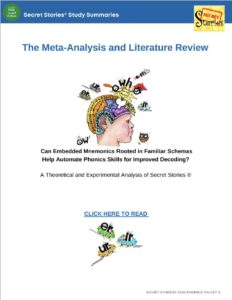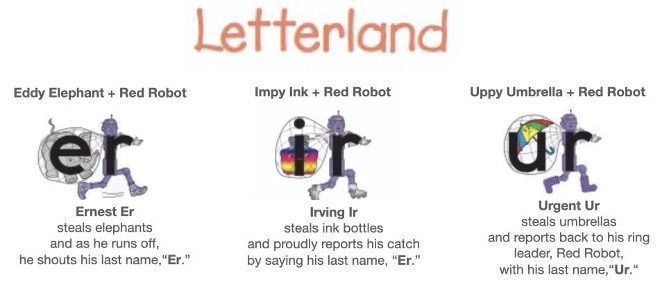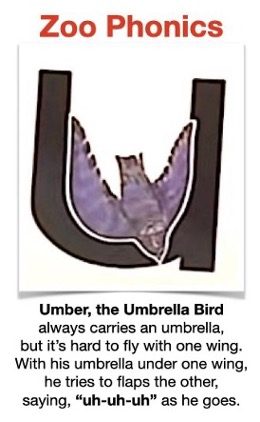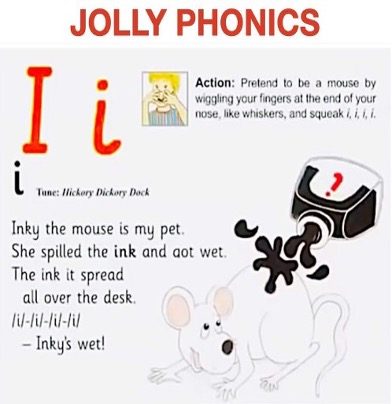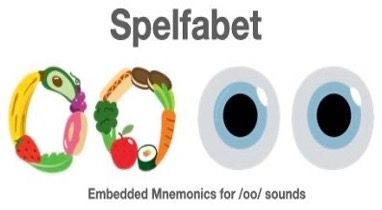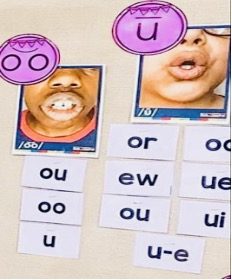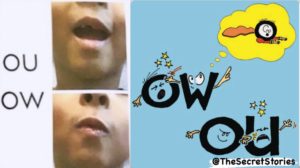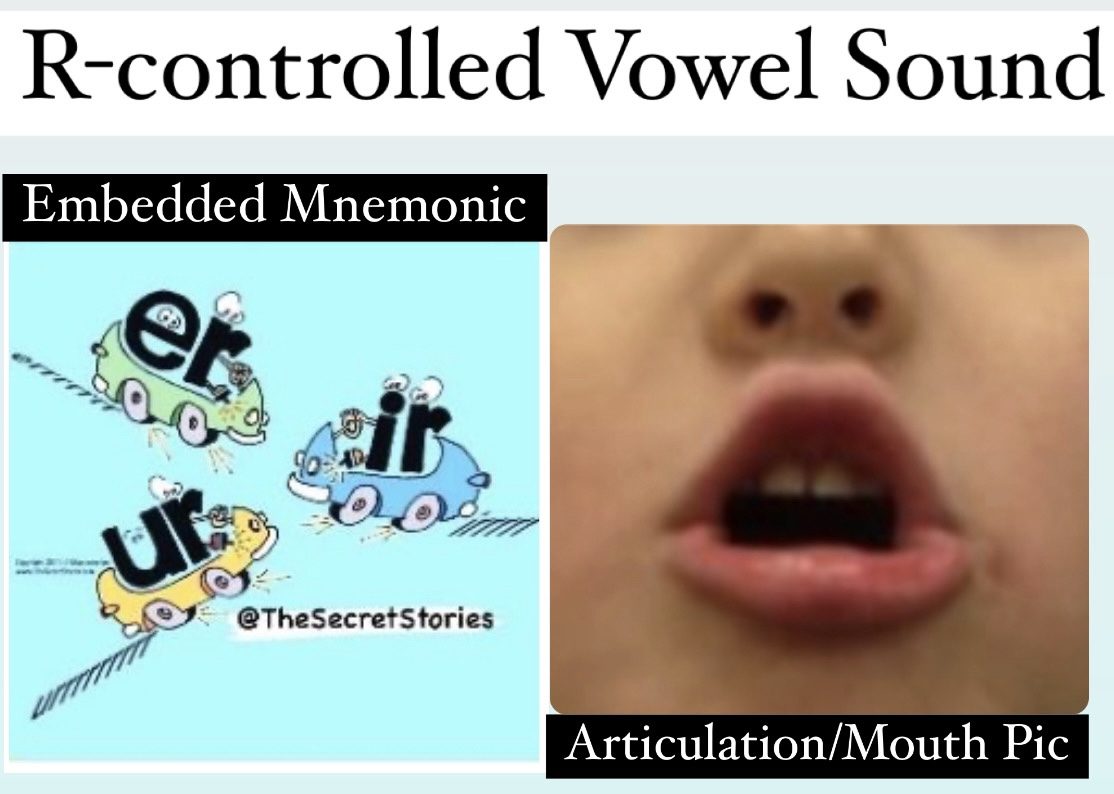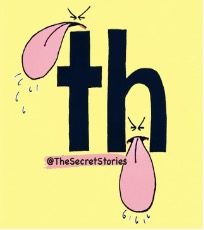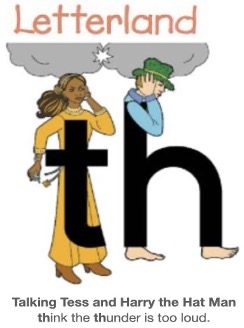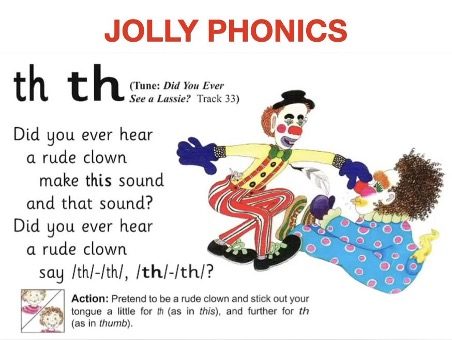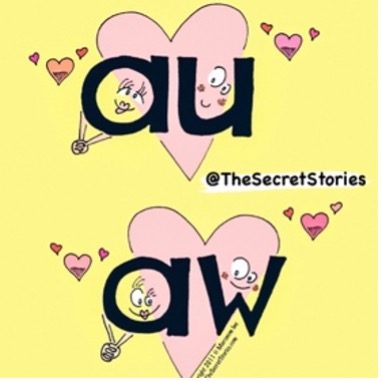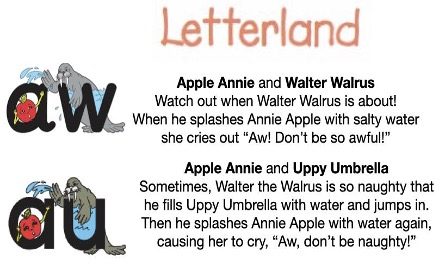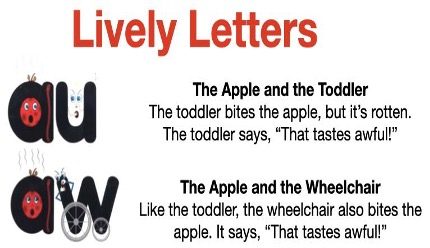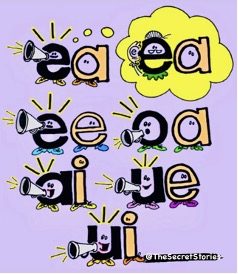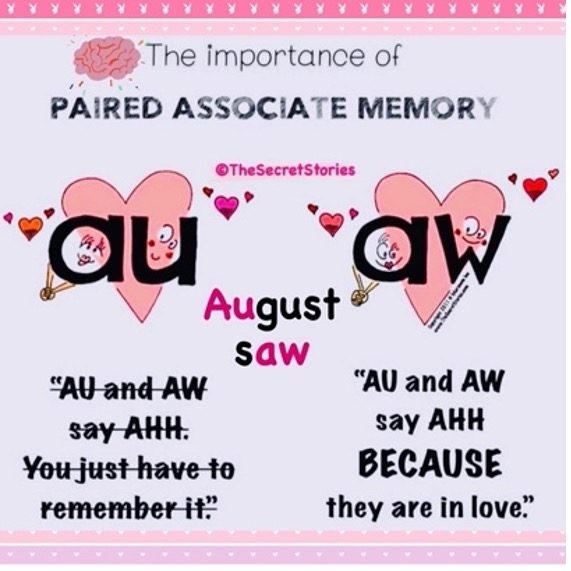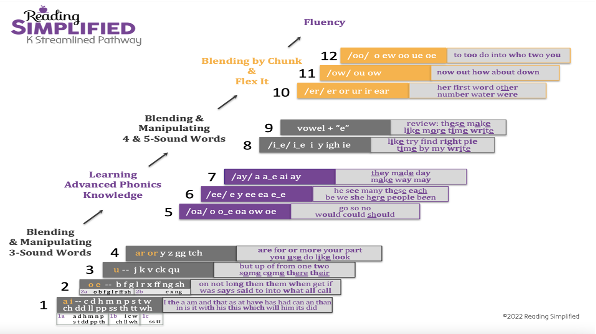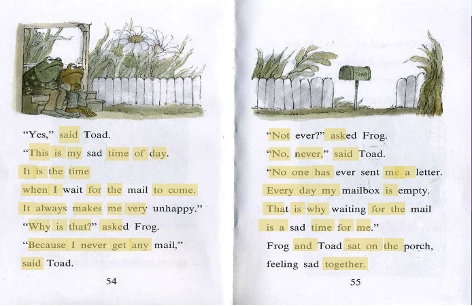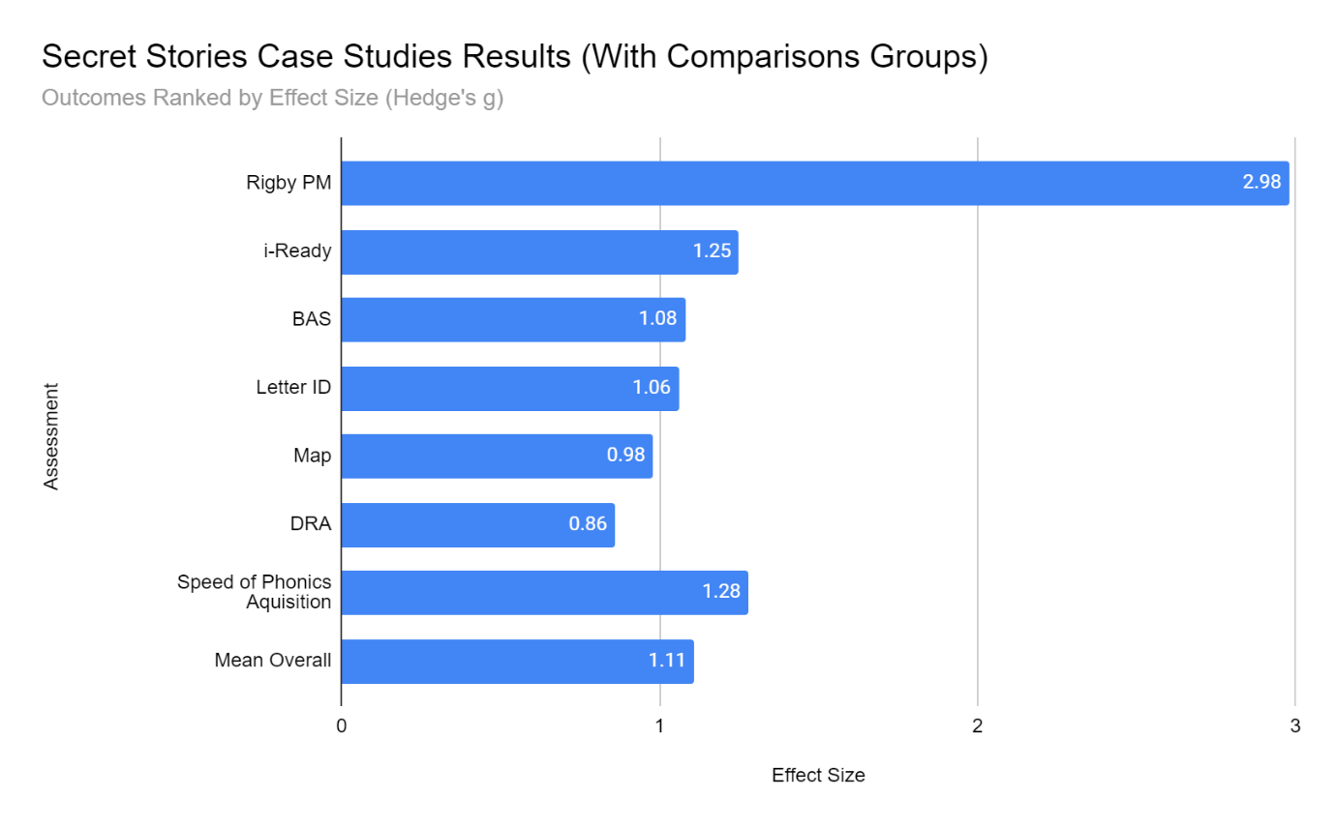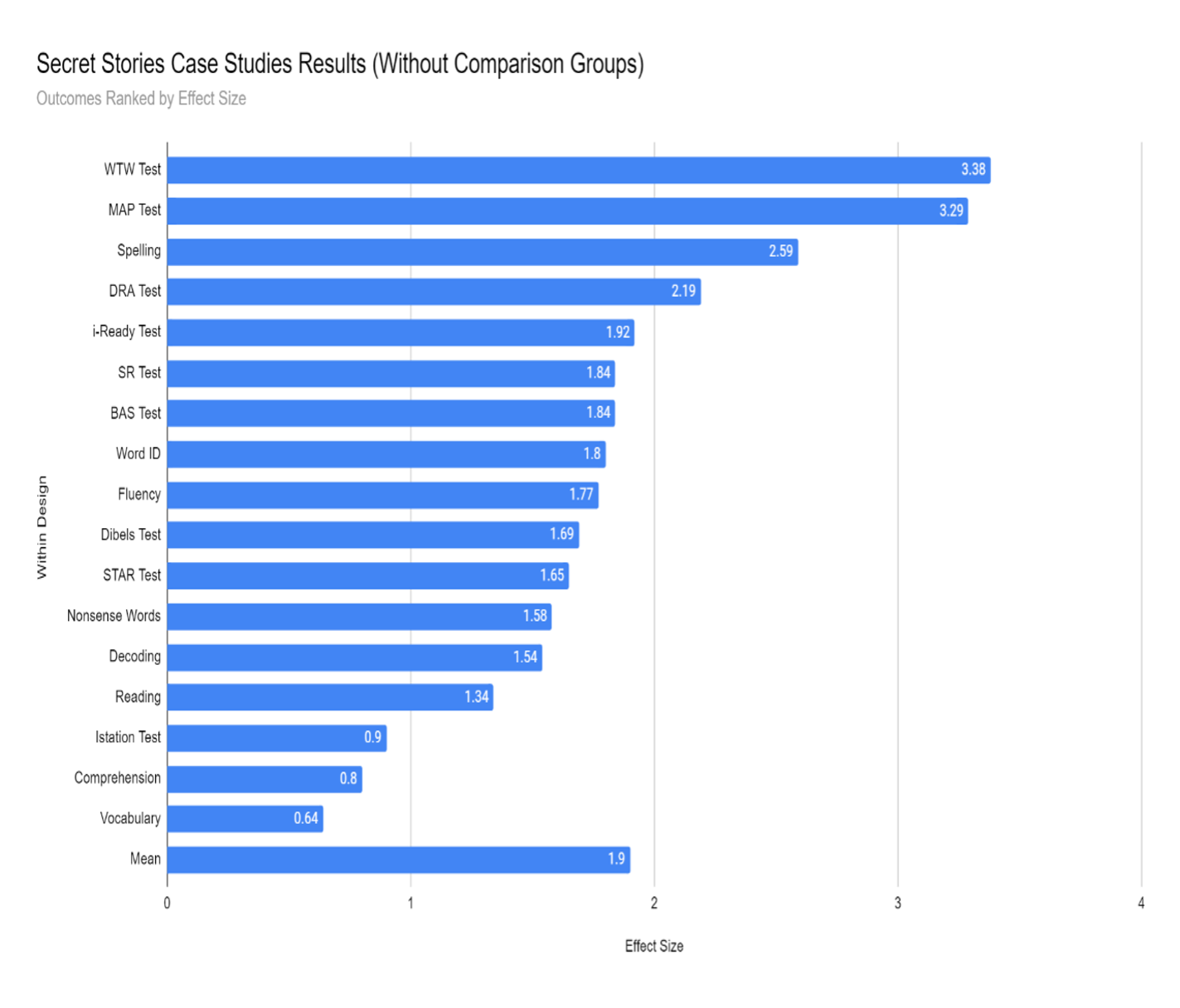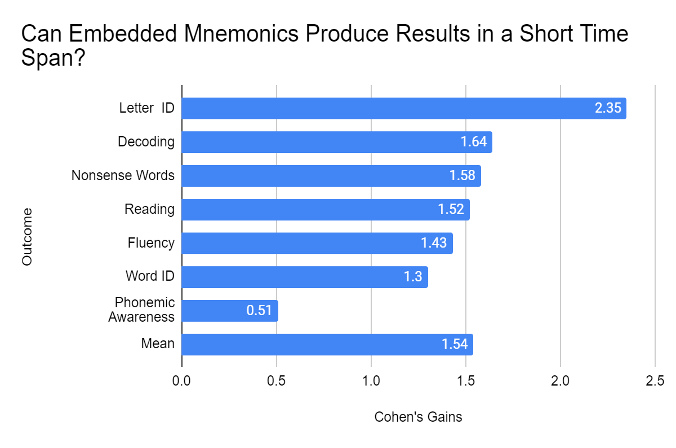Secret Stories® Tier I Research
Can Embedded Mnemonics Rooted in Familiar Schemas
Help Automate Phonics Skills for Improved Decoding?
A Theoretical and Experimental Analysis of Secret Stories®
Katie Garner, Nathaniel Hansford, Joshua King, Sky McGlynn & Elizabeth Reenstra
Authors Notes
The author, Katie Garner, wrote the literature review section for this paper. Katie Garner is the creator of Secret Stories® Cracking the Reading Code with the Brain in Mind. The author, Marnie Ginsberg, contributed to the section of the literature review on instructional speed. The authors, Nathaniel Hansford, Joshua King, Sky McGlynn & Elizabeth Reenstra were contracted to conduct an independent efficacy evaluation of the Secret Stories embedded mnemonics, based on secondary analysis. To ensure the integrity of this research, a strict ethics agreement was signed by all parties.
Table of Contents:
Abstract
Introduction
Literature Review
Types of Mnemonic Devices: Melodic, Schema, Embedded
Traditional Use of Mnemonics
—Dr. Linnea Ehri
—Cognitive Load Theory
Theoretical Limitations of Embedded Mnemonics
—Letterland
—Zoo Phonics
Rapid, Simultaneous Skill Acquisition via Multiple Memory Systems
—Better Alphabet® Song
—Dr. James Asher
Rational Mnemonics
—Zoo Phonics
—Jolly Phonics
—Spelfabet
—Articulation/Mouth Pics
Good, Better & Best Stories for Learning
—Dr. Helen Immordino-Yang
—Dr. Pam Snow
Affective “Feeling” Based Connections
—Dr. Helen Immordino-Yang
—Dr. Pam Snow
—Dr. Letterland
—Jolly Phonics
—Lively Letters
Early Brain Development
—Marilee Sprenger
Patterning and Decoding
—Shifting the Balance/ Dr. Jan Burkina & Kari Yates
—Stanford Sight Word Brain Study/ Dr. Bruce McCandliss
Cognitive Flexibility and Phonics
—Tim Shanahan
—Hierarchy of Likelihood/ Sound Defaults
A Playground for Critical Thinking
—Shifting the Balance/ Dr. Jan Burkina & Kari Yates
—Dr. Mark Seidenberg
Access to Phonics Information and Speed of Instructional Delivery
—Dr. Mark Seidenberg
The Current Study
—Methodology
—Results
—Speed Analysis
—Discussion
—Limitations
References
Abstract
Over the last several decades, embedded mnemonics have been established as a proven strategy for teaching letter names and basic letter sounds. Indeed, many programs make use of mnemonics or embedded mnemonics to teach basic phonics and letter identification (ID), including but not limited to: Jolly Phonics, Letterland, Zoo Phonics, Lively Letters, and Spelfabet. However, many scholars have posited that embedded mnemonics are limited in their usefulness to primarily basic letter sounds and letter ID. Within this paper, we make the theoretical argument for use of more sophisticated embedded mnemonics to teach more complex phonics skills beyond the basic letter ID and sounds.
Additionally, we conducted a meta-analysis of case studies on Secret Stories, which uses mnemonic devices to maximize the speed of phonics skill mastery and can be used alongside any existing reading or phonics curriculum. The Secret Stories mnemonics were developed based on early brain development research and cognitive theories to give beginning readers access to as much of the phonics code as possible, as soon and as fast as possible. It provides a visualized phonics framework for explicit decoding instruction that serves as both an instructional and retrieval tool, helping children understand the essence of letter-sound connections and quickly put them into practice.
For the purposes of this analysis, a review of 27 case studies was conducted. For 15 of these case studies, an effect size was calculated by comparing the treatment group either to a control group or to assessment standards. For 6 of these case studies, an effect size was calculated by comparing pre and post-test scores. For 6 case studies, no effect size could be calculated due to the lack of a comparison group, or no pretest having been administered. For studies with control groups, a mean Hedge’s g effect size of .72 was calculated [.37, 1.06] (k=9). For studies based on comparing treatment groups to assessment benchmarks, a mean Hedge’s g effect size of 1.55 was calculated [.60, 2.23] (k=7). For studies without a comparison group, a mean effect of 1.90 [1.53, 2.26] (k=13) was found. A weighted mean effect size of .78, was also calculated for studies with control groups, based on an inverse variance model. Lastly, a regression analysis was conducted to control the impact of study design quality on effects. Most effect sizes found were very high and suggest that Secret Stories is a promising choice for improving phonics outcomes. However, all of these case studies were the result of secondary analysis and were not conducted via a true experimental design. In a commitment to further the scientific research on the subject, we hope to follow up with further RCT studies on the use of embedded mnemonics for extended phonics instruction. Additionally, the U.S. Department of Education (ED) has also requested research studies on Secret Stories as part of their evaluation of the Striving Readers Comprehensive Literacy Grant Program and observed gains made.
Introduction
The Reading Wars debate raged between whole language scholars and phonics scholars for much of the latter half of the 20th century. While whole language scholars believed that reading was a natural process, structured literacy scholars argued that it was not and should be first taught explicitly, via grapheme-phoneme correspondences, so that students can decode unfamiliar words. Whole language scholars argued that teaching phonics was inherently unengaging and that it would lower students’ motivation to learn how to read.
In the early 2000s, the United States government commissioned the National Reading Panel to investigate the reading wars issue and to present a scientific consensus. This led to one of the first and largest meta-analyses of the topic. The NRP meta-analysis found that, on average, systematic phonics instruction showed an effect size of .44 and that whole language programs showed a mean effect size of .05. This research showed that, on average, phonics instruction was vastly superior to whole language instruction. This seminal paper essentially ended much of the reading wars debate, as most of the scientific community accepted that whole language instruction was inferior.
Literature Review
That said, there is less research on how best to teach phonics. One promising area of research has been mnemonics-based phonics. Mnemonic strategies integrate something known with something unknown, helping the brain to create a schema to store and retrieve new information more efficiently and effectively. Cognitive Load Theory (CLT) proposes that human cognition is divided into two distinct regions: working memory and long-term memory. Working memory is extremely limited, dealing only with ongoing activities and immediate decision-making, whereas long-term memory has infinite storage capacity and is capable of storing vast amounts of information in “schemas” that can be accessed quickly (Arbib, 1992; McVee et al., 2018). Schemas are categories of previously learned information that have been built up over time. As a schema constitutes just one element, it effectively bypasses the limits of working memory (Sweller, van Merrienboer & Paas 1998, p. 255). The formation of schemas help to reduce the load on working memory by providing a foundation for knowledge organization and storage. This gives rise to automatic processing in certain tasks where schemas already contain substantial accumulated knowledge (Flavell et al., 1985; Sweller et al., 1998). Although the number of elements that working memory can manage is still limited (Arbib, 1992; McVee et al., 2018), schemas are a useful tool in helping to bridge the gap between working and long-term memory and provide an efficient method for accessing information quickly.
There are three types of mnemonics that can help students learn and automate phonics knowledge: melodic mnemonics. story schemas and embedded mnemonics.
Types of Mnemonics
-
Melodic Mnemonics
Music can work as a mnemonic to help facilitate and automate recall (Lehmann & Seufert, 2018). Music-based mnemonics consisting of familiar rhythms or melodies can be used to quickly engage student attention and provide a pathway for easier skill connections and information retrieval (Guo, Wang, 2022; Purnell-Webb & Speelman, 2008; Wallace, 1994). Studies have demonstrated that information is better recalled when heard as a song rather than as speech, provided the music repeats so that it is easily learned (Wallace, 1994). It is the familiarity of the melody and rhythm that helps to facilitate this recall (Purnell-Webb & Speelman, 2008).
-
Story-Schema Mnemonics
Stories act as memory aids that enable learners to learn and remember phonics skill concepts more efficiently. This is especially true when stories are based on familiar “schemas” of early learner experience and understanding, especially when they are associated with an emotionally charged image or sound, as this helps store the information into long-term memory more easily (Baddeley et al., 1998).
-
Embedded Mnemonics
Well-crafted illustrations in which letter patterns are embedded directly into images that depict their sound (or sounds) provide shortcuts for interpreting and connecting phonics skill information. Illustrations are often the quickest way to communicate large amounts of complex information that would be complicated to explain (Duchastel & Waller, 1979).
Traditional Use of Mnemonics
There has been a large amount of research showing that embedded mnemonics, specifically, are effective for this purpose of teaching phonics. Ehri et al. (1994) showed through two investigations that pre-readers who were taught letter–sound associations through integrated picture mnemonics learned more letter–sound associations than did their peers who were not exposed to the mnemonics. With an embedded mnemonic, a picture is embedded within a symbol to help strengthen the connection. A commonly used example would be to make the letter “s” look like a snake.
Embedded mnemonics help children remember and retrieve the links between the letters and their associated sounds by creating a meaningful and strong paired association between them. The benefit of dual coding phonics information in this way is that children receive information about letters in both pictorial and orthographic modalities (e.g. Sadoski, 2005; Sadoski & Paivio, 2001).
Integrating the letters with the sound picture enhances memory because the information is stored twice and can work together in facilitating later recall of the information (Paivio, Allan. 1991). This helps to reduce cognitive load and increase working memory capacity, improving memory (Ayres, P., Kalyuga, S., Sweller, J., 2011). Additionally, when one memory trace is lost, the other remains accessible (Kanellopoulou C, Kermanidis KL, Giannakoulopoulos A., 2019).
Research on Cognitive Load Theory (CLT) proposes that human cognition is divided into two distinct regions: working memory and long-term memory. While working memory is limited, dealing only with conscious activities and immediate decision-making, long-term memory has an infinite storage capacity, capable of storing vast amounts of information in “schemas” which can be accessed quickly and easily (Arbib, 1992; McVee et al., 2018).
There exist many phonics programs which teach phonics, via mnemonics, stories, and songs. By linking grapheme-phoneme correspondences with songs, mnemonics, or stories, it is hoped that they are more meaningful to young students and thus easier to learn. Indeed, Jolly Phonics and Letterland are two phonics programs that function based on these well-studied principles. Both Dr. Timothy Shanahan and Dr. Linnea Ehri have pointed out that these types of practices can improve phonics outcomes.
In fact, Dr. Ehri gave the following speech at the 2022 AIM Institute Annual Research to Practice Symposium.
“To move children into the next partial phase, they need to acquire alphabetic skills. They need to learn letter shapes, names, and sounds. Once they know letter names, it’s easy to learn the phonemes contained in the names, for example: ‘b’ contains /b/, ‘m’ contains /m/, in fact most of the letter names contain their phonemes.
We’ve conducted studies to see how to help children learn grapheme-phoneme relations. We used embedded picture mnemonics like those shown in the slide. On the left are Annie Apple, Eddy Elephant and their letter friends from the Letterland program. The figures on the right are useful for teaching the five short vowel relations; Annie Apple says /a/, Eddy Elephant says /e/, […] Uppy Umbrella says /u/. Short vowel phonemes are not found in letter names, so having a mnemonic is helpful for teaching them.”
Of course, while Dr. Ehri and Shanahan’s most current statements on this might be relatively recent, this research has been around for decades. Indeed, the NRP meta-analysis also concluded that mnemonics are helpful in the following quotation from their report:
“In 1997 US Congress commissioned the National Reading Panel “to assess the status of research-based knowledge, including the effectiveness of various approaches to teaching children to read.” The NRP report was published in 2000. The panel’s research focused on a number of “topics for intensive study” including ‘phonics instruction’. This included an examination of “the value of mnemonics for teaching letter-sound relations to kindergarteners”. [The report states] “that there was evidence to support the use of mnemonics in teaching letter-sounds.” (NRP, 2001).
Jolly Phonics and Letterland are both well-studied programs that use mnemonics to teach single letter grapheme correspondences. In 2022, Nathaniel Hansford and Joshua King conducted a meta-analysis of popular language phonics programs, including Jolly phonics. Across 4 experimental and quasi-experimental studies, they found a mean effect size of .91, higher than any other language program included in the study. Similarly, an RCT study was conducted in 2019, by Robert’s et al. on Letterland.
The study was 13 hours long and had a sample of 38 pre-kindergarten students. In the treatment group, the students received Letterland programming. In the control group, the students received the identical curriculum, but without the multi-sensory or mnemonic elements. The treatment group outperformed the control group on every assessment. However, the assessment was a non-standardized assessment, which sometimes inflates effect sizes. The author’s calculated effect sizes (ES) using Cohen’s d formula. The study found a mean ES of .75, with 1.31 [4.08,6.26] for letter ID, .61 [2.05,4.59] for phoneme ID, .62 [2.90,5.27] for phonemic awareness, and .46 [3.55,8.44] for writing. On average, Letterland and Jolly Phonics both show research outcomes that are far above average.
However, there are limitations to this research. There was only 1 Letterland study, and it was only 13 hours long with a sample size below 50. Only one of the Jolly Phonics studies used a true experimental design, and it did not look at academic outcomes. That said, this research is promising and helps to demonstrate that phonics programs that are mnemonics-based increase engagement by making the phonics instruction more meaningful to students.
Stories are natural mnemonics. Evolution has wired our brains for storytelling; they are woven into our DNA (Speer, Reynolds, Swallow, & Zacks, 2009). Stories act as memory enhancers, helping to establish supportive conditions in the brain for learning and remembering by activating the brain’s positive emotional state. Stories make phonics more interesting, and more importantly, they help hook the information into a strong memory-holding template.
The structure of a story provides a sort of mental map upon which new information is more easily laid. Narrative improves information processing, increasing recall of, and interest in, the story (Glaser et al., 2009; Hong and Lin-Siegler, 2012). Most importantly, the narrative increases recall of the material that’s presented in the story (Töpper et al., 2014).
Theoretical Limitations of Embedded Mnemonics
While Dr. Ehri, has posited that embedded mnemonics are useful for accelerating students’ understanding of basic letter identification and phonics, she has been critical of expanding this practice past single letters and sounds.
“While there are commercially available programs that use mnemonics, many are unlikely to be successful because there are too many associations to remember, and the associations are not personally relevant” (Shmidman & Ehri, 2010).
Moreover, mnemonics that present information that is too complex, lacks relevance or provides insufficient sensory stimulation will be more difficult to learn (Sousa, 2006). Take, for example, Letterland’s embedded mnemonic for the r-controlled vowel sound as seen below.
Figure 1: Letterland Embedded Mnemonics for Controlled R
It requires multiple story associations due to its use of individual characters for each letter, each with their own individual sound story (Annie Apple says /a/; Eddy Elephant says /e/; Uppy Umbrella says /u/; Red Robot says /r/).
While these individual letter-sound associations seem logical and relevant—at least to English-speaking students—all logic and relevance is lost when they are used in association with completely unrelated phonics sounds. Herein lies the difficulty with traditional use of mnemonics for phonics instruction; their efficacy is limited to single phonics sounds.
Secret Stories is an embedded mnemonics phonics tool that was specifically designed to address this limitation. The Secret Stories embedded mnemonics are unique in that they extend to digraphs and trigraphs and were designed with the express purpose of making logical and meaningful sound connections that are based on what early learners already know.
Rohwer (1966) investigated various kinds of associative mnemonics for young children and found that the best connectives for remembering pairs of pictures or words were meaningful “actor-action-object” relations. Moreover, the more meaningful the connection, the more likely the memory will be enhanced. These findings were also found in (Davidson & Adams, 1970; Ehri & Rohwer, 1969; Lippman & Shanahan, 1973; Rohwer & Levin, 1968; Rohwer, Lynch, Levin, & Suzuki, 196, & Levin 1983).
Consider the Secret Stories embedded mnemonic example below which uses the familiar sound of screeching brakes to elicit the same r-controlled vowel sound. In this example, the phonics patterns are embedded within a mnemonic device that depicts a logical story, one that is readily familiar to children. This simple sound association would become far too confusing if each letter were embedded with its own mnemonic, as the connections would be too random, too difficult, and too many to remember.
Figure 2: Secret Stories Embedded Mnemonics for Controlled R.
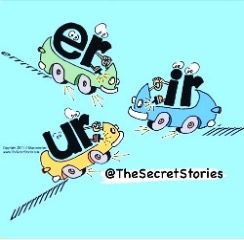
In contrast, Secret Stories embedded mnemonic provides a clear connective that helps students visually associate the phonics patterns with the sound. In addition to the embedded mnemonic is a “secret” story, which is that these letters are “terrible, awful, horrible, no-good drivers” and that they always “slam on the brakes,” causing the familiar “ERRRR!”sound that children love to make when playing with cars.
The secret story contains both “given” and “new” information. The “given” information is what students would be expected to have in their background schema or memory (i.e., riding in a car that stops fast) and the new information is the phonics pattern(s) to which it is connected. Additionally, pairing phonics skills with what children already know and understand helps make them interesting and meaningful, aiding in their retention (McNamara, G., 2012).
Comparatively, teaching the same phonics skill using Letterland’s mnemonic device would require learning 7 story associations: Eddy /E/, Impy /I,/ Uppy /U/ and Red Robot /R/ for the individual letter sounds, and Ernest /Er/, Irving /Ir/, and Urgent /Ur/ for the 3 phonics patterns—as opposed to teaching only 1 secret story.
Moreover, in order for students to learn and remember these story associations, they must be practiced repeatedly in daily lessons and over multiple grade level lessons. In contrast, the secret story doesn’t need to be “taught,” as it relates back to what children already know and have personally experienced, which is the feeling and sound of a car stopping fast. In this way, skill transfer is automatic, which lets students put into practice what they are learning to independently read and write.
Rapid, Simultaneous Skill Acquisition via Multiple Memory Systems
The traditional difficulty with using embedded mnemonics in story-based phonics programs is application of a story association for each individual letter sound. This means when letters come together to form digraphs or trigraphs, all these stories need to connect.
The Secret Stories framework avoids this confusion by eliminating the need for individual letter characters, and instead, teaching letter sound identification using a melodic mnemonic, known as the Better Alphabet® Song. Learning individual letter names and sounds in a sung modality allows the melody and rhythm to serve as mnemonic aids to ease retrieval.
The melody and rhythm of a song can help facilitate learning and recall. Research suggests that information is better recalled when heard as a song, rather than as speech, provided that the music repeats so that it is easily learned (Wallace, 1994). It is the familiarity of the melody and rhythm that helps to facilitate this recall (Purnell-Webb & Speelman, 2008).
Using familiar melodies and rhythms as mnemonics for easy recall of information has been used successfully in clinical contexts with those suffering from multiple sclerosis, aphasia, or Alzheimer’s disease (e.g., Goldfarb and Bader, 1979; Moore et al., 2008; Simmons-Stern et al., 2010). Patients with these diseases often have difficulty recalling new information.
In such cases, music can work as a mnemonic to help facilitate recall (Lehmann & Seufert, 2018). Aniruddh D. Patel, Ph.D., a scientist at the Neurosciences Institute in California, theorizes that rhythm and song, which are inherently predictable, may create a “supra-linguistic” structure that helps cue what is coming next in an utterance.
With the Better Alphabet Song, it’s the singing of each letter name that cues its sounds. This requires that each letter-sound pattern is sung 8 times to engage muscle memory and automate retrieval. Unlike a traditional song, the melody of the Better Alphabet® Song is repeated, over and over again for each letter-sound pattern, which effectively “breaks” the song into 26 mini-songs that are sung together as one.
When using muscle memory to help automate (letter-sound) skills, it is necessary to break the information apart in this way to ensure its flexible retrieval (Csikszentmihalyi, 1990). This allows learners to sing any letter name, in any order, and retrieve its sound(s) without having to start at the beginning of the song and sing to the desired sound. The ability to use the articulation of a letter’s name to help automate retrieval of its sound is a function of both the melodic mnemonic and the natural engagement of muscle memory.
Muscle memory, also called motor learning, exists outside of conscious thought. It is a separate and distinct memory system that operates independently of higher-level, cognitive processing (Oxford University, 2017) by consolidating specific motor tasks into memory through repetition (Asher, 2012). When a movement is repeated over time, muscle memory is created for that task, allowing it to be performed without conscious effort.
Automating the retrieval process decreases the need for attention and supports maximum efficiency of the motor and memory systems (Krakauer & Shadmehr, 2006) allowing learners to focus on more complex tasks. “Studies prove that the body remembers as well as the mind, and for some learners, even better” (Asher, 2012). This is especially true for very young children, whose cognitive processing centers are underdeveloped, as well as for older students with cognitive deficits. For these learners, the conscious mind may work more slowly and be less adept and efficient at processing information. In both cases, muscle memory can provide a faster and more reliable pathway for skill retrieval (Williams, 2017).
In addition to using music to automate retrieval of the individual letter sounds, Secret Stories also uses music to help automate retrieval of the phonics patterns and sounds, clearing the pathway from sound-to-symbol (for encoding) and symbol-to-sound (for decoding) to get children used to traveling both ways for reading and for writing.
Because the Secret Stories mnemonics framework makes use of a different memory system to elicit automatic recall of the individual letter sounds, there is no cognitive confusion caused by learning the secret stories about the phonics sounds letters make together.
By providing beginning readers with simultaneous access to the sounds letters make individually and the sounds they make together, Secret Stories helps them to make sense of the words they encounter throughout the day. Moreover, without the need to add 26 additional individual letter sound stories, Secret Stories is free to craft the most logical and relatable story associations for each phonics sound. This helps to ensure they are meaningful and relevant, and that their sound associations are easily predictable.
Rational Mnemonics
There are “good, better and best” when it comes to stories, and the best stories are the ones we already know—those rooted in familiar frameworks of human experience and understanding. These are common denominators that we all share, even kindergartners. This is important because kindergartners are the target audience for beginning reading and letter sound instruction. Thus, for a story narrative to be effective, it must follow a child’s line of logic. In other words, it must draw connections from that which a 5-year-old knows and understands.
Research suggests that stories provide a way to entice an audience that may otherwise not be interested, or an audience that requires extreme simplification—like kindergartners. When communicating complex information to “non-expert” audiences, the use of stories, anecdotes, and narratives becomes not just appropriate, but important (Dahlstrom, 2013).
Stories can be used to make complex information easier to understand, providing an easily accessible framework for structuring, storing, and retrieving information (Haven 2007). However, not all stories are created equal. While all stories are narratives, not all narratives are effective stories for teaching and learning (Dalkir and Wiseman 2004).
Ineffective stories have only a weak association with the information. They lack logic and consistency, complicating the generalization, rather than simplifying it (VA Shaffer, BJ Zikmund-Fisher, 2013). Accuracy is essential in a good narrative, as it draws its power from the truths that underlie the story (Martinez-Conde S, Alexander RG, Blum D, Britton N, Lipska BK, Quirk GJ, Swiss JI, Willems RM, Macknik SL., 2019).
In the below Zoo Phonics story example (bottom left), the short /u/ sound is associated with the sound of a bird named Umber who is carrying an umbrella and flying with one wing. While the story is entertaining, the association is illogical.
The association is made even weaker by use of a bird character to depict the sounds of /u/, especially given the more obvious association of the word “bird” with the letter /b/. Similarly, the Jolly Phonics example (bottom right) uses “Inky the Mouse” to teach and help students recall the alternative sound of /i/.
Figure 3: Embedded Mnemonics for Zoo Phonics and Jolly Phonics
The weaker the story association, the more difficult it will be to teach and to learn, and the harder it will be for students to remember.
In contrast, stories that rely on familiar narratives that are logical and well-aligned with the information require fewer cognitive resources for comprehension and can lead to enhanced learning (Fisch, S.M., 2000). For example, it’s easier for children to remember the secret story about Mommy e® and Babysitter Vowels®, who will always remind any vowel that’s one letter away to “say its name,” than it is to remember an arbitrary association, like “magic e” or “sparkly e.” This is because children understand the concept of doing what they’re told by a parent or a babysitter, especially when they’re standing nearby.
However, children have no prior knowledge or understanding of what to do when something magical or sparkling is nearby. Additionally, the “magic e/ sparkly e” strategies apply only to words that end with an /e/, whereas with Babysitter Vowels, students can use the same line of logic to help them decode longer, multisyllabic words, even in kindergarten. This is because the phonics rule is based on an already familiar, social schema, which is having to listen to an authority figure. These simple strategies make it easy for beginning readers to understand how sounds and syllables work so as to quickly identify whether a vowel will be long or short in any word.
Whereas Secret Stories taps into what a 5-year-old already knows, many programs use embedded mnemonics that rely on a higher level of learner readiness and skill ability for use. For example, in the Spelfabet embedded mnemonic example below, the sounds of /oo/ are associated with pictures of fruit and eyes.
Figure 4: Spelfabet Embedded Mnemonics
In order to use these associations to read and spell, students must first be able to identify the objects pictured and know the English words for them. Then they must be able to segment the sounds in those words and discern which one relates to the mnemonic. In addition to requiring an English language background and a certain level of developmental readiness, this process also requires an awareness and understanding about letter-sound relationships that most 5-year-olds don’t naturally possess. It must be taught.
This is the typical process that students must go through with traditional letter-sound picture cues, including those with embedded mnemonics. However, in the Spelfabet example, there is the added confusion that’s caused by using fruit pictures in association with the spelling pattern /oo/, given that the word “fruit” is spelled with the phonics pattern /ui/ and not /oo/.
Another, more recent way of visually associating the phonics patterns with their corresponding sounds articulation (mouth), which show mouths and tongues shown in various positions alongside the corresponding phonics patterns.
Figure 5: Articulation (Mouth) Pictures
While not embedded mnemonics, the articulation pictures are intended to serve a similar purpose, which is to create a sound wall that students can reference for independent reading and writing.
For example, to decode an unknown word, students would need to identify the letters/letter patterns in the word that are on the wall. Then, using a handheld mirror, students must match their mouth shape and tongue position to the pictures that correspond with each letter/letter pattern to sound out the word.
To encode or spell a word, this process is reversed. Students observe the position of their mouth and tongue as they segment each sound in the word they want to write. Then, they look for the mouth(s) that most closely match their own and copy the corresponding letter(s) for each sound.
This process is quite involved and requires many steps, especially given the number of sounds, and thus mouth positions in each word. Complicating this process even further is the fact that some phonics patterns, like the ou/ow diphthong example below, are comprised of two or more sounds, each requiring multiple mouth pictures, as compared to the Secret Stories® embedded mnemonic for the same sound.
Figure 6: Mouth Articulation Pictures vs. Embedded Mnemonics Posters
In answer to a question posted in a 2021 Reading Rockets article, Dr. Timothy Shanahan addressed the lack of research and inherent difficulties associated with students using mouth pictures as a sound wall for independent reading and writing.
What are your thoughts about [mouth picture] sound walls?
“…As usual, my first concern was, “What does the research have to say?” That’s easy. Research is mute on this issue.
[A]s a practical memory aid, they’re weak (more useful for the teacher as a guide to presentation than to the kids as a guide to reading words).
I guess the idea would be that when a student comes to a challenging word, he/she could go to the word wall, find the right combination of graphemes, and examine the pictures of the articulatory apparatus in the hopes that replicating that shape would lead to proper sounding out of that word.
My take?
That’s far too cumbersome as a memory aid—about as practically useful as the lists of 3-cueing clues that some teachers provide: “If you come to a word you don’t know, look at the picture. If that doesn’t work, read to the end of the sentence”…Memory aids need to be easy to access or people just don’t use them” (Shanahan 2021).
On the topic of embedded mnemonics, Dr. Shanahan explains in this 2022 blog post how the research widely supports the use of embedded mnemonics for improved learning to help children remember the letter sounds:
“Across various studies (Ehri, 2014; Ehri, Deffner, & Wilce, 1984; McNamara, 2012; Schmidman & Ehri, 2010) it has been found that embedded mnemonic pictures can reduce the amount of repetition needed for kids to learn the letters and sounds, with less confusion, better long-term memory, and greater ability to transfer or apply this knowledge in reading and spelling.
If one relies on data rather than reasoning, the answer is kind of a no-brainer—it is a good idea to use embedded mnemonics…
When it comes to teaching letters and sounds, there’s no question about it, use embedded mnemonics. They work.” (Shanahan, 2022).
“Good, Better & Best” Stories for Learning
Unlike random pictures and unrelated words, stories have the potential to put the whole brain to work and are one of the most effective ways to engage multiple areas of the brain simultaneously. This is important because the more widespread the connections, the deeper the learning. The more brain areas we use, the more neurons fire, and the more neural networks change—and thus, the more learning occurs (Immordino-Yang, 2017).
Delivering information through stories promotes the formation of multi-layered memories, which result in deeper learning experiences and easier skill retrieval (Zull, 2011). When you tell a story, you engage different senses in the listener’s mind— sights, sounds, and even feelings. The brain becomes more active, prompting higher levels of learner engagement.
Moreover, concepts presented in a story-based format receive a higher level of priority in the brain, often using an emotional hook to engage curiosity.
“The external stimuli that make it past the brain’s mental filters tend to be of two varieties: those that stir emotions and those that arouse curiosity (typically in that order). Our brains default to ignoring almost everything else” (Goodwin, Gibson, Ruleau 2020).
Eliciting emotional arousal improves the odds that listeners will engage with the material (Morris et al., 2019). Stories have the power to transform students’ thinking about information they might otherwise think is boring, hard, or not important to their lives. (Immorindo-Yang, 2017). Even in history or algebra, when new information is presented in a familiar story form, the memory structure facilitates the brain’s retention of that information (Willis, 2009). Such intrinsic benefits for learning can greatly enhance phonics instruction.
Storytelling is one of the fastest and easiest ways to trigger emotional engagement in the brain. Whereas traditional “rule-based” phonics instruction evokes no emotional response, mnemonics-based instruction has the potential to trigger emotional arousal and provoke curiosity in tandem with cognitive processing. This helps to mark the information for memory and prioritized learning in the brain. Stories provide familiar context by following a structure of logical cause-and-effect relationships, which in turn, allows students to develop a schema for better internalizing phonics knowledge.
A schema is a cognitive framework or concept that helps us organize and interpret information. The use of schemas allows us to take shortcuts in interpreting vast amounts of information (McLeod, 2023). Secret Stories aligns phonics knowledge with “social” schemas, which include general knowledge about how people behave in certain situations; more specifically, how children behave in certain situations.
Schemas can play an important role in the learning process. They influence what is paid attention to and how incoming information is interpreted. We learn information more quickly and easily when it fits in within our existing schemas.
Schemas help us to simplify and make sense of things, so as to be able to classify and categorize new information by comparing it to what we already know. Schemas can help learners assimilate new information automatically, allowing them to think more quickly. For example, children are more likely to pay attention to and recall the sound of “screeching brakes” (Figure 2) than they are to the r-controlled vowel sound because it fits into a familiar schema.
In a speech given at the 2021 Reading League Conference, Dr. Pamela Snow reiterated this point by explaining the impact that sensory stimulation and activity can have on attention and learning:
“If you’re close to the road and there’s traffic noise, that probably wouldn’t be getting through to your cortex, but if there were screeching brakes or sirens, that would get over the threshold where it does get to the cortex [….] and once we get past sensory memory, then we have the opportunity to get it into the working memory system” (Snow, 2021).
With Secret Stories, the r-controlled embedded mnemonic (Figure 2) helps learners visually connect the letter patterns with the sound. The use of this concrete schema can help students map new information and shorten the learning process for automation (Van Merrienboer & Paas, 1990).
Additionally, the visualized thinking framework helps to facilitate instructional talk and make the teaching and learning approach both explicit and constructive (Guo, 2020).
“When seeing those phonics patterns in words, students will be able to think more quickly to retrieve their sound. This is important because in addition to being efficient, phonics instruction must also be equitable. Education materials and practices cannot assume all students talk in a certain way or share the same experiences or background knowledge, as such assumptions are not valid and make learning difficult” (Seidenberg, 2022).
The Secret Stories mnemonics draw skill connections from universal frameworks of experience and understanding, like playing rough and getting hurt (ou/ow), sticking your tongue when you’re mad (th), having a crush and being embarrassed (au/aw), having to listen to your mom or babysitter (open/closed syllables), knowing “where and when” to be sneaky (sounds of /y/), etc. In this way, Secret Stories mnemonics offer a common ground for all learners, regardless of age, language, or socio-economic status.
“Our brains are wired to make connections, and it’s easier to learn and store information when there is a familiar hook to hang it on. That hook is background knowledge, which includes the human experiences and emotions that we all share” (Immordino-Yang, 2017).
Affective “Feeling” Based Connections
Affective Learning refers to learning that is based in feeling and emotions. “It is neurobiologically impossible for children to think deeply about things they don’t care about” (Immordino-Yang, 2017, n.p.).
Cloaking phonics skills as “secrets” makes them important to kids, something they are curious about and want to know. This, in turn, sparks engagement in the affective “feeling” domain, making phonics skills relevant, meaningful, and easier to understand for children.
Drawing on familiar frameworks of social and emotional experiences helps children construct meaning for increased understanding. The emotional connection that results from making learning personally meaningful and relevant is what differentiates rote assimilation of material from deep mastery and durable learning. Through emotion, synapse strength is modified, and the responsiveness of neuron networks can be dramatically changed. Emotion and thought are physically entangled. We feel emotions in our body, and the way we feel influences our brain (Immordino Yang & Damasio, 2007).
Deep understanding depends on making emotional connections between concepts. Emotion guides our learning. The emotional brain filters all incoming information. If information is emotionally stimulating, it will be marked for memory and prioritized for learning. Emotions signal the brain, “Keep this, this is important.”
The best and most durable learning occurs when content sparks interest and is relevant to a child’s life.
“When students find the right connections, they will learn. They won’t be able to help themselves” (Immordino-Yang, 2017).
There is substantial evidence linking motivation to reading achievement by activating, directing, and sustaining goal-directed behavior. Enhancing meaning, creating situational interest, and activating imagination are instructional features that increase motivation. These features are essentially affective, and therefore most likely to enhance the valuing component of motivation (Guthrie & Wigfield, 2000; Morgan & Fuchs, 2007; Sweet, Guthrie, & Ng, 1998; Taboada, Tonks, Wigfield, & Guthrie, 2009).
Secret Stories draws on affective learning connections that link letter behavior to kid behavior, making phonics more interesting and the different sound letters make more predictable. For example, in the secret story about /th/, the letters aren’t allowed to sit together, but they don’t listen. That’s why they can be found together on every line, on every page, in every book, and they’re always sticking their tongues out at each other, and saying, ‘Thhhhhhh!’”
Figure 6: Secret Stories Embedded Mnemonics for /th/
This phonics sound association makes sense, even to 4 and 5-year-olds because it fits within a familiar social schema. Children know that when friends are angry and not getting along, they will sometimes stick their tongues out at each other. They also know the sound that’s associated with that action.
Unlike phonics skills, emotions and behaviors simply exist; we don’t have to learn them (Asher, 2012). The fact that /th/ can feel and act the same way that we do makes it interesting, meaningful, and memorable, even for very young children who don’t know the names of the letters. With Secret Stories, one skill set is not reliant on the other for acquisition, nor for application, as it is with traditional phonics instruction or reading “programs.”
For example, children can learn the “secret” about /th/ even before they have mastered their individual letters sounds, as each skill resides in a different memory system. In fact, using the Secret Stories embedded mnemonic, even preschoolers can figure out the sound that /th/ is making by simply looking at the picture, without ever having been taught the story.
However, this is not the case with either the Letterland or Jolly Phonics embedded mnemonic examples below that are used to teach the same /th/ sound. In fact, even after learning these stories, these associations remain unclear.
Figure 8: Letterland and Jolly Phonics Embedded Mnemonics for /th/
Because the /th/ secret story hooks into what children already know, they gain immediate access to this critical phonics pattern that’s needed to read and write many of the most high-frequency words, like: the, this, that, them, those, they, then, etc. Alternatively, without Secret Stories, students would have to wait an entire year until first grade for formal introduction of the /th/ digraph on the grade level scope and sequence.
Similarly, the secret story about au/aw having a crush on each other and getting embarrassed when they’re together also draws on affective or “feeling” based learning connections.
Figure 9: Secret Stories Embedded Mnemonic for /au/
In this case, the emotion of love is a useful paradigm to teach these sounds—not only because it offers a rational explanation for the sound being made, but also because it is a feeling that most children understand from a very young age.
The secret story helps children learn and remember the sound, and the embedded mnemonic provides for quick and easy reference to read and spell words, like: saw, draw, awful, August, etc. In this way, Secret Stories is both an instructional and retrieval tool—forging “sound-symbol” connections in the brain and then providing access to the connections that it stores.
In stark contrast are the the Letterland and Lively Letters examples below that are used to teach the same au/aw phonics sound. Both stories incorporate individual letter sound characters into the phonics stories, making the connections appear arbitrary and illogical.
Figure 10: Letterland and Lively Letters Embedded Mnemonics for au/aw
Early Brain Development: A “Backdoor” for Earlier Learning
There are three main domains of learning, which include: cognitive (thinking), affective (social/emotional) and psychomotor (physical/kinesthetic). Because the brain matures from back to front, the earlier-developing, affective networks are more primed for learning than the slower-developing, cognitive “thinking” centers (Sprenger, 2013).
While sensory lobes in the back store feeling-based memories, the frontal lobes house the executive processing centers, which focus on critical thinking and problem-solving, and are the last to develop (Knox, 2010). “When we talk about executive functions, we’re talking about things like higher-order cognitive skills, such as attention, planning, organization, self-monitoring, working memory, impulse control, all things that develop relatively late and are not developed in typical 5-year-olds” (Snow, 2021). Moreover, the cognitive “thinking” domain requires conscious effort and attention to be applied for learning, whereas the affective “feeling” and psychomotor “physical” domains do not (Sprenger, 2013).
Learning occurs naturally and non-consciously through these earlier-developing, neural networks. Most of what we learn happens implicitly, without conscious awareness. This type of learning starts in infancy. (Seidenberg, 2021). Thus, brain maturation is an extremely important aspect of early learner development, and an understanding of the process is critical to appropriate early grade instruction and lesson design (Corsini, Craighead, & Weiner, 2010).
Most of what we learn occurs at the nonconscious, sensory level, and the non-conscious mind is responsible for the bulk of our mental processing. Learning at this level is fluid and effortless, with visual cues, sounds, experiences, and feelings processed by multiple memory systems and in varied learning domains (Asher, 2009). The ability to teach through the brain’s “backdoor” can have a tremendous impact on learning and memory (Sprenger, 2021). Channeling phonics skills through these earlier developing and already primed “backdoor” learning channels shifts the instructional emphasis from skill practice to skill understanding.
Unlike traditional phonics instruction, which targets later developing, executive processing centers through the rote memorization of skills, Secret Stories draws on connections that students can see, hear, do, feel, and understand. It does this by actively engaging students in the learning process as they “see” the letters, “say” the sounds, and “feel” the connections. Whether sticking their tongues out like /th/ or pretending to slam on the brakes like er/ir/ur, these movements prime the molecular processes that help form memory (Chaddock-Heyman, Hillman, Cohen & Kramer, 2014).
The student’s body is our best ally for transmitting and receiving messages on the first exposure (Asher, 2012). Secret Stories’ multisensory, mnemonic-based approach to phonics instruction enhances learner recall and aids in phonics skill transfer to long-term memory. Additionally, by engaging the body in the physical process of recalling the sound, the information is dual-coded, meaning that it’s stored twice in the brain, with different memory systems working together in facilitating later recall of the information (Paivio, Allan. 1991). This helps to reduce cognitive load and increase working memory capacity, improving memory (Ayres, P., Kalyuga, S., Sweller, J., 2011). Additionally, when one memory trace is lost, the other remains and is accessible (Kanellopoulou C, Kermanidis KL, Giannakoulopoulos A., 2019).
Presenting new material in a way that helps students see relationships between concepts generates greater brain cell activity and achieves more successful long-term memory storage and retrieval (Sprenger, 2021). Fusing meaning and logic into letter behavior makes sounds more predictable and phonics concepts easier to understand, even for kindergartners. It allows kindergartners to store and retrieve advanced phonics skill knowledge as easily as their older and more developmentally ready, second grade peers.
What’s “used together becomes fused together” in the brain (Wu & Zenke, 2021) and recognizing that learning is essentially the formation of new or stronger neural connections, it makes sense to tap into pre-existing, learner understanding for new skill acquisition. Creating this association between new knowledge (e.g. phonics skills) and existing knowledge (schemas) helps to strengthen memory retention and recall.
Through its strategic delivery of phonics instruction, Secret Stories triggers activation of one neural network over another so as to effectively “bypass” inherent areas of learner-weakness and tap into alternative areas of strength. Doing so repeatedly causes the brain to change and adapt as a result—reorganizing pathways, creating new connections, and in some cases, even creating new neurons (Immordino-Yang, 2017).
Patterning and Decoding
The brain is a natural pattern-making machine, constantly seeking out patterns and creating new ones. This patterning system facilitates our interpretation of the world and helps us to make sense of incoming information throughout the day—coding, storing, connecting and retrieving information (Willis, 2009). Memories are stored based on these patterns—the repeated relationships between ideas, based on prior experiences. Quite apart from anything the teacher does, the student, being human, is a pattern finder, and a pattern maker (Bronson, 1977).
In the book, “Shifting the Balance,” Dr. Jan Burkins and Kari Yates explain:
“The brain is a natural puzzle solver and releases endorphins when we solve a problem (Tik et al. 2018). It loves to find patterns and figure things out, and it is wired to reward us for our efforts. So, as children use the secrets we’ve taught them for cracking bits of the code— noticing, comparing, and applying phonic patterns—their brain can reward them for their efforts (Dweck 2017). The up-front support we provide with beginning to solve the great puzzle of our written code not only sets children up for success in the moment, but is also proven to increase reading motivation, reading volume, and confidence down the road (Kirsch et al. 2002; Anderson, Wilson, and Fielding 1988; McArthur and Castles 2017).”
Detecting a pattern within a sequence of ordered units, defined as patterning, is a cognitive ability that is important in learning and influential in learning to read (Bock, Cartwright, McKnight, Patterson, Shriver, Leaf, Mohtasham, Vennergrund, Pasnak, 2018). It is wise for teachers to take advantage of the brain’s natural inclination to seek patterns when teaching reading (May, 2022).
However, the traditionally slow pace of phonics skill introduction at the beginning grade levels makes this extremely difficult. This is because the individual letter sounds that beginning readers do know often appear contradictory to the sounds they observe letters making in words they encounter across the day, as well as in the reading program.
For example, in kindergarten, students are taught that the letter /t/ makes the sound that can be heard at the beginning of the word “turtle.” However, in the overwhelming majority of words, the letter /t/ will appear to be making a completely different sound, as in the words: the, this, them, they, those, there, then, etc. For this reason, students need access to this high-frequency phonics pattern sooner, not later.
Whereas Secret Stories provides access to this phonics pattern from the very beginning of kindergarten (Figure 4), most traditional phonics scopes and sequences delay introduction until late fall/early winter of first grade, teaching it as a “consonant digraph.” This intentional delay results in kindergartners and beginning first graders having to memorize hundreds of words that could otherwise be easily decoded. Such discrepancies between the sounds letters make individually and the sounds they make together in words can make it difficult for beginning readers to consistently apply the few decoding skills they have been taught.
It is important to teach consistently in ways that do not invalidate or contradict what we have previously taught (McGuinness, 1999). However, this is virtually impossible when the majority of words that beginning readers encounter throughout the day—including in the reading curriculum—require phonics skill knowledge that hasn’t been taught yet. To compensate, teachers must rely on rote word memorization, devoting valuable instructional time to teaching the “reading” instead of teaching the “reader.” Indeed, many easily decodable words are memorized as sight words, even when mnemonic devices can make decoding easier and virtually eliminate the need for memorization, as shown below.
Figure 11: Secret Stories Embedded Mnemonics
Stanford University Professor, Dr. Bruce McCandliss, studied brain waves to see how different teaching methods affected reading development and found that beginning readers who focus on letter-sound patterns (rather than trying to memorize whole words) increase activity in the area of the brain best wired for reading. Additionally, decoding words elicited neural activity biased toward the left side of the brain, whereas words learned through rote memorization showed activity biased toward right hemisphere processing.
Dr. McCandliss noted that this strong left hemisphere engagement during early word recognition is a hallmark of skilled readers and is characteristically lacking in children and adults who are struggling with reading. Moreover, study participants were subsequently able to read new words they had never seen before, as long as they followed the same letter-sound patterns they were taught to focus on. Within a split second, the process of deciphering a new word triggered the left hemisphere processes, and that is the brain circuitry we are hoping to activate in beginner readers (McCandliss, 2015).
When considering that research suggests active decoding triggers optimal brain engagement in the left hemisphere and word memorization prompts less desirable engagement on the right, the need to accelerate the code becomes even more important. By bringing to light the cerebral foundations, cognitive neuroscience studies of reading can help spread the word and eventually lead to a more systematic and rational approach to reading education (Dehaene, 2010).
Yet, structured literacy programs still rely heavily on memorization of easily decodable words until the phonics skills needed to decode them are formally introduced. Instruction in letter-sound relationships is of little value or utility unless the child can use those letter-sound relationships to read or write (Adams, 1990).
While a phonics scope and sequence is key for any core reading/phonics curriculum to ensure that all skills are covered, it should not block access to phonics skills that are so easily acquired and in words that students must read every day.
Supplementing existing reading or phonics curriculum with more sophisticated embedded mnemonics like Secret Stories accelerates access to the code-based skills needed to read and write years before they are formally introduced on the grade scope and sequence. This is important because the words that beginning readers encounter in the reading program are leaps and bounds ahead of the phonics skills that it’s teaching them, as are most of the words they encounter throughout the day.
As children increase the number of sound-spelling correspondences they know, they also increase the number of opportunities to reinforce them (2006, McGuinness). Only by accelerating access to more of the phonics code sooner can beginning readers take the maximum value away from the reading program and daily reading and writing activities. Without the code that’s needed to read and write, these experiences hold far less instructional value.
Secret Stories helps teachers keep pace with students’ needs for daily reading and writing, without the need to spend valuable instructional time on rote skill and word memorization. It balances teaching phonics skills with using them, not just during the reading block, but across the entire instructional day as students refer to the embedded mnemonic posters to read and write words in all content areas. It is through this ongoing retrieval process that phonics skills become automated.
In a 2021 speech at the Reading League Conference, Dr. Pamela Snow addressed the importance of maximizing instructional time and opportunities for use in regard to phonics instruction:
“We need to be using instructional approaches that maximize the bang for buck on time in the classroom. It’s not enough to have a smattering of phonics in there somewhere […] Children need to encounter a word probably 3 to 5 times before it enters their sight vocabulary and becomes automatized. Orthographic mapping comes from lots of practice and exposure using decodable text to support early practice and consolidation of grapheme phoneme correspondences taught” (Snow, 2021).
Cognitive Flexibility and Phonics
Research shows a strong correlation between patterning performance (the ability to recognize patterns) and cognitive flexibility. In a study designed to examine relations between first-grade students’ executive functions, patterning, and reading abilities, results showed that cognitive flexibility was correlated with patterning performance.
The study (Abreu, 2014) focused specifically on poor readers identifying four factors for analysis: inhibition, selective attention, interference suppression, and a factor combining working memory with cognitive flexibility. The latter factor was the only one that differentiated good readers from poor readers. This relationship between working memory and cognitive flexibility/ patterning are similar to those reported by Bock et al. (2015) and Schmerold et al. (2017) for 6-year-olds (Bock, 2018).
Embedded mnemonics provide a visual thinking framework that helps support the interplay between working memory and cognitive flexibility. Both memory and processing speed play pivotal roles in reading success, which is why automating phonics skills is so important. Only then are students able to think flexibly and use what they know to puzzle-out new words. It is in this way that
Secret Stories uses embedded mnemonics to mobilize phonics knowledge. For example, not only are the phonics patterns embedded into the Secret Stories mnemonics, but a logical hierarchy for use, as well. This can be seen in the embedded mnemonic for ou/ow below, which incorporates both possible sounds for these letters, but within a logical framework of “most” and “next most” likely, based on the story.
Figure 12: Secret Stories Embedded Mnemonic for ou/ow
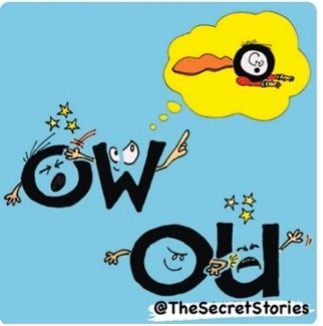
In the secret story, /ou/ and /ow/ always play rough and get hurt, causing them to cry, “oww!” While this sound is the most likely for these letters, in words like: how, now, about, around, etc., they can also make the long /o/ sound, in words like: know, blow, though, thorough, etc.
This secondary “default” sound is also embedded into the mnemonic, with “Superhero o” flying overhead, which causes the letters to point and yell his name as he flies by, “O!” since he is their “all-time, favorite superhero!” Incorporating sound defaults into embedded mnemonics that students can reference independently helps to support the cognitive flexibility needed for decoding, as does establishing a hierarchy of likelihood for use.
From as early as preschool, children know and understand that when you get hurt, you say, “Owww!” Yet, this phonics skill is not formally introduced in most reading or phonics programs until second grade. Not only does this require students in kindergarten and first grade to memorize hundreds of words; it also robs them of the ability to read them, taking away thousands of opportunities to analyze, problem-solve and think critically about the sounds of letters in text.
These opportunities are what strengthens and supports cognitive flexibility. The brain grows through enrichment, and development advances when learners experience a challenge just beyond their level of present mastery (Sprenger, 2013).
Secret Stories places a premium on both knowledge-building and problem-solving by providing a visualized phonics framework for explicit decoding instruction. The embedded mnemonics act as a tool to guide students’ thinking for problem-solving (Walker, 2019), as they perceive the sounds in question, recognize the letters or spelling patterns, and then link those two things together to decode and encode words. Aligning phonics skill concepts with social schemas helps students internalize patterns of thinking to support cognitive flexibility and creative problem-solving for flexible decoding. This ability to “flexibly decode” is a natural outcome of Secret Stories use.
Dr. Timothy Shanahan has addressed the importance of cognitive flexibility as a key component of highly effective phonics instruction.
“Phonics instruction should sensitize students to alternative sound-symbol relations and spelling patterns. That way when misreading a word like bread as “breed,” the student has available some other pronunciation choices for that /ea/” (Shanahan, 2022).
In keeping with Dr. Shanahan’s example, the secret story explains both sounds for /ea/, with the “next most likely” one off to the side in yellow.
Figure 13: Secret Stories Embedded Mnemonics
Equipping beginning readers with this flexible phonics knowledge is critical to their ability to effectively decode unknown words. Kids who lack this knowledge lack flexibility and are at a disadvantage (Shanahan, 2022). Proficient decoders must be flexible, sensitive to orthographic patterns, comfortable with approximate results, and self-correcting. They must be able to deal with these complexities in a flexible manner. (e.g., Gibson & Levin, 1975).
The need for cognitive flexibility is an essential property of proficient decoding ability. Yet, it is virtually impossible for beginning readers to develop a flexible approach to decoding if they have only a few phonics skills to draw upon. Only by accelerating access to the code can learners build up the resources they need to make sense of what’s going on, to make predictions, and to solve problems.
The brain stores information in an associative manner so that contextually related information is connected in memory. These associative connections help to support the brain’s ability to generate predictions in given contexts (Shenhav A, Barrett LF, Bar M., 2013). The brain quickly and efficiently activates relevant associations that give rise to predictions (Bar, 2004, 2009; Chun & Jiang, 2003; Oliva & Torralba, 2007). Predictive processing across both cognitive (thinking) and affective (feeling) domains allows for associations between a given stimulus and outcome to be rapidly computed and used for generating corresponding predictions (Shenhav, Barrett, Bar, 2013). An example of this paired association can be seen in the Secret Stories example below.
Figure 14: Secret Stories Embedded Mnemonics
A Playground for Critical Thinking
The framework of a story provides the perfect playground for this predictive process. The Secret Stories mnemonics help children become curious about how words work, how letters go together, and how to be flexible when dealing with exceptions. Its visual thinking framework helps students broaden and organize phonics knowledge, and the use of embedded mnemonics provide earlier access to complex phonics information, helping to develop the building blocks for creative problem-solving.
In the book, Shifting the Balance, Dr. Jan Burkins and Kari Yates explain that-
“Engagement and explicit instruction do not need to be mutually exclusive (Burkins & Yates, 2021). The brain is a natural puzzle solver and releases endorphins when we solve a problem (Tik et al. 2018). It loves to find patterns and figure things out, and it is wired to reward us for our efforts. So, as children use the secrets we’ve taught them for cracking bits of the code— noticing, comparing, and applying phonic patterns—their brain can reward them for their efforts (Dweck 2017). The up-front support we provide with beginning to solve the great puzzle of our written code not only sets children up for success in the moment, but is also proven to increase reading motivation, reading volume, and confidence down the road (Kirsch et al., 2002; Anderson, Wilson, and Fielding 1988; McArthur & Castles 2017).”
The brain loves novelty, and we become more mindful when we encounter novel stimuli that do not fit established categories, and when we are motivated to engage in systematic, logical deduction, rather than lapse into mindless processing (Zimbardo & Leippe, 1991). Explicit phonics instruction is a commitment to letting kids in on the secrets we know about how symbols and sounds match up to make readable words (Snow & Juel 2005). Rather than teaching rules and then teaching words that don’t follow them, beginning readers and writers should use what they know to be flexible and problem-solve.
Within the familiar framework of a story, children can talk effortlessly about what letters are doing and why. They can also talk about what they’re not doing, or what else they “might” do, which helps to strengthen cognitive flexibility for decoding new words. Stories provide learners a format of comprehension to better simulate possibilities (Oatly,1999) and to make better predictions about cause-and-effect relationships (Read & Miller, 1995).
Through the familiar storylines, children can recall the information they need to puzzle-out an alternative course of word attack. All of the options are written into the stories, which are what holds it all together. Presented in this way, phonics skills become something that children can grab onto and use. They know why they’re learning them, and even play a part in their discovery. Within this learning framework, children aren’t passive learners, but active participants.
For example, children might notice Mommy e® isn’t making the vowel say its name in words, like: have, river, because, etc. Simply letting them in on the “secret” that “Sometimes Mommy’s there, but she’s just too tired to care!” helps them to account for the discrepancy, move on to the next most likely sound, and successfully decode the words. Children understand that sometimes mom is too tired to make them do what they should, and that Mommy e is no different.
Using a familiar line of logic lessens the load on children’s working memory and supports their ability to think critically. In a similar way, students might notice the strange sound the vowels are making in the words: come, some, of, was, want, what, love, done, etc. Rather than simply memorizing words with a “schwa” sound, the secret story explains that- “Sometimes vowels just can’t make up their minds whether to be long or short and so they have to think about it, saying “uhhhh?” while they are thinking.” The vowels in these words aren’t just schwas, they’re Thinking Vowels®, and knowing their secret story helps children decode words, that by traditional phonics standards, are “undecodable.”
When viewed through the lens of familiar schemas (e.g., Mommy E, Babysitter Vowels, Thinking Vowels, etc.,) the identification of syllable types to determine whether a vowel will be long or short becomes child’s play, even for kindergartners.
Dr. Mark Seidenberg poses the following question regarding the challenge of teaching syllable types to young children:
“Is there really a rule, or might there be a better way to discuss the same thing? Memorizing rules is especially hard for those with language challenges, and it’s really unclear what the benefit is. They introduce a large amount of cognitive load and can distract from the text. Some of these syllable division rules also simply do not align with the way our language works.”
Seidenberg proposes alternative instructional approaches, such as “explicitly teaching a flexibility strategy” and “grouping words with similar patterns while providing masses of practice.” In an interview with Dr. Marnie Seidenberg on his May 2022 podcast, Reading Matters with Mark and Molly: Conversations Bridging Science and Practice, Dr. Ginsberg also stresses the need for instructional efficiency in reading instruction, while emphasizing the importance of keeping the ultimate goal in mind.
“Everything we teach needs to be in the service of reading. We cannot allow ourselves to get lost in the tasks or in the weeds and forget that it is all a means to the end of real reading and writing. We must use the most efficient and impactful activities and routines to get to this goal quickly.”
By providing access to more of the phonics code faster, students are able to apply their phonics knowledge more widely across the entire curriculum. Skill-transfer is built in and automatic, as teachers using the embedded mnemonics to read and write words in “real world” instructional contexts throughout the day.
Secret Stories gives teachers the freedom to introduce, reinforce and elaborate on these skills in a variety of text scenarios, supporting more flexible use. In this way, the mnemonics become highly transportable tools for thinking that students can learn in one context and then transfer to other situations over time, until the strategy application has become routine and internalized. “Instruction designed to improve learners’ thinking can also help to advance it, with persistent impact, and with some degree of transfer to other contexts and occasions” (Ritchhart & Perkins, 2005).
Access to Phonics Information and Speed of Instructional Delivery
This section was co-authored by Dr. Marnie Ginsberg, Katie Garner and Nathaniel Hansford.
Figure 15: Reading Simplified Scope & Sequence
Given what is known from these research strands about cognitive flexibility and orthographic depth, many mainstream phonics programs do not provide beginning readers with either the necessary phonics information (i.e., “ea” or “er”) or the understanding of the nature of our code (e.g., one sound can have multiple spellings) to achieve these skills.
For example, a typical phonics progression for kindergarten covers only short vowels, consonants, and only a small handful of consonant digraphs. In such an environment, at the end of 180 days of schooling, the child will not have had the opportunity to practice much cognitive flexibility because her access to the code has been so constrained. Nor will she have been taught, or likely discovered, that one spelling, such as “o” can represent 2 or more sounds.
These systems, therefore, are out of alignment with contemporary research on the importance of cognitive flexibility. For the first year of instruction (and often several months beyond that), the child has not been given the opportunity to test out different sounds for a given spelling. In addition, she has been indoctrinated to believe that the English writing system has a transparent orthography in which 1 spelling is always a predictable sound. To avoid these pitfalls teachers can provide more rapid access to phonics information, as well as to the earlier revelation of the true nature of our alphabetic writing system.
For example, using Secret Stories, teachers can provide earlier and faster access to phonics skills in advance of the program-based scope and sequence. Similarly, with the Reading Simplified® system, many kindergarten children will have advanced through the 12 levels of the Streamlined Pathway (see image above) in about 4 months, having learned all the sufficient phonics information necessary to develop Share’s (1995) self-teaching skills. From the earliest lessons, kindergarten teachers would also have taught digraphs such as “th” and “ch” to prevent the beginning learner from assuming one sound is always one letter and vice versa.
In both of these environments, the beginning kindergartener could exit her first year of instruction knowing many sounds and spellings often reserved for just 1st or 2nd graders. And she will also have begun to practice the complex skill of flexing the vowel sound in words to cope with the opaque nature of the English spelling system.
Figure: 16: Frog and Toad Decodable Passage
How can a reader learn to automatically recognize words such as “time,” “day,” “never,” “why,” or “together” unless he had been taught or discovered the necessary spelling patterns (“i_e”, “ay”, “er”, “y”, or “er”) in those words and then also had sufficient reading and writing practice with these patterns and words for the words to become orthographically mapped? Programs that release much more phonics information rapidly and allow beginners to deepen their understanding of orthography will potentially better prepare more children to achieve the lucky Matthew effects status.
The reasoning of the above example aligns with what Vadasy and Sanders mean when they write, “The scope and sequence for most alphabet instruction has not been informed by consideration of orthographic depth, the complexity, and predictability of GPCs (Schmalz, Marinus, Coltheart, & Castles, 2015), although greater precision in design may improve rates of learning this necessary skill” (2020). Indeed, through two experiments Vadasy and Sanders demonstrated that low-skilled K-1 students, including ELLs, benefited from a faster pace of introduction of letter sounds as well as the inclusion of multi-letter graphemes, such as /sh/ or /ck/ (2020).
We are gaining more and more evidence that the one-letter-a-week instructional tradition is out of alignment with contemporary reading research. Despite this rationale, many mainstream reading programs use scope and sequences that only teach 1-2 grapheme-phoneme correspondences per week. Such programs may not grant the average student access to sufficient phonics information to develop solid phonological decoding skills, in a time-efficient manner.
A meta-analysis by Hansford, et al, conducted in 2022 on phonics programs showed that faster scope and sequences showed higher effect sizes, r= .52, p-value = .001. However, Hansford et al showed that there was an upper limit to how fast phonics could be taught. Diminishing returns were found for programs with scope and sequences that exceed 15 grapheme correspondences per month. Lower improvements were also found for scopes and sequences that were individualized to student needs. These results suggest that a faster pace of instruction is key, but that too fast of an instructional pace can also lower learning outcomes. However, Hansford et al did not look at whether or not other forms of instruction, such as connecting phonics knowledge with pre-existing schemas of learner-understanding could increase the rate of effective instruction.
As Secret Stories is not a program, it does not have a scope and sequence. Thus, it can be used alongside any reading or phonics curriculum to accelerate learner access to the code. While other programs include daily lessons with comprehensive instructional routines, Secret Stories mnemonics live neatly inside the daily reading and writing that’s already happening to maximize the instructional value of existing curriculum.
The goal of this approach is to advance the speed of phonics instruction, giving learners access to as much of the phonics code as possible, as fast and as soon as possible. Through this visualized phonics framework for explicit decoding instruction, teachers can help children understand the essence of letter-sound connections and put them into practice.
The Current Study
As previously established, there is strong scientific evidence for the use of embedded mnemonics to teach phonics and letter identification. However, there is minimal scientific evidence that these mnemonic devices can be used to teach more complex grapheme phoneme correspondences. Moreover, many scholars have specifically theorized that doing so would be of little value, given that the associations would be too numerous and thus, too difficult for children to remember, especially since the stories behind the mnemonic devices are too arbitrary to come together in a logical fashion. Secret Stories was specifically designed to address these problems by using contextually logical mnemonics that come together in a rational way. In order to test the efficacy of this concept, 27 case studies were conducted by an independent third party company, via secondary analysis.
Methodology
Case studies were divided into 3 main levels of quality. For the lowest quality case studies, a mean difference between the start and end of the year was analyzed. Six studies fell into the lowest quality category. For medium quality studies, Hedge’s g effect sizes were calculated by comparing pre and post assessments for a single treatment group. Seven studies fell into the medium quality category. For the highest quality studies, a Hedge’s g effect size was calculated by comparing the post test results of the treatment group to a comparison group. Thirteen studies fell into the highest quality study category. Within the high-quality category, seven studies compared results either against benchmarks, district scores, or projected scores. Six studies compared the post test results with an actual control group. Two studies used a randomized design in which control group students were randomly selected from a pool of students matched for pre-test scores. All studies were conducted by retrospectively examining student learning results. No studies were initiated in advance using proper experimental procedures. A small follow-up randomized control trial is ongoing to examine the efficacy of Secret Stories mnemonics, under more rigorous experimental conditions.
To ensure the integrity of this research, several steps were taken. All parties signed a strict ethics agreement that required all results to be shared, regardless of whether or not they were positive. All parties agreed to share results, regardless of the outcomes of the research. All parties agreed to conduct the research in such a manner that was ethical and beneficial to science. Treatment teachers were contacted by the case study researchers and interviewed to ensure authenticity. The third author conducted the initial statistical analysis for each case study, which was then reviewed by a 4th and 5th author independently to ensure statistical reliability. Additionally, a second third party research firm was hired to review the completed case studies and to ensure the integrity and reliability of the first third party’s research.
Results
| Study Name | Mean ES Between | Mean ES Within |
| Secret Stories Tier 1 RCT | 1.06 | |
| Indiana Cohort Study | 1.29 | |
| West Virginia | .48 | .74 |
| Idaho Study 1 | 1.35 | |
| Florida Study 2 | 1.65 | |
| Florida Study 3 | 1.05 | |
| Michigan Study 1 | .52 | |
| Florida Study 1 | 2.98 | |
| Arkansas Study 1 | .74 | |
| Tennessee Study 1 | 1.42 | |
| California Study 2 | 1.2 | 2.19 |
| Maryland Study 1 | .47 | 2.36 |
| Maryland Study 2 | .41 | 1.62 |
| Indiana Study 1 | 1.29 | 2.3 |
| Ohio Study 1 | 1.5 | 2.12 |
| Oregon Study 1 | 1.9 | |
| Virginia Study 1 | 3.01 | |
| Georgia Study 1 | 1.89 | |
| Georgia Study 2 | 1.83 | |
| Florida Study 3 | 2.2 | |
| Idaho Study 2 | .90 |
Table 1: Studies Included in Meta-Analysis
*Note: Between Designs means the effect size was based on a comparison or control group. Within Design means the effect size was based on pre to post gains. The tier 1 RCT study is a working paper and will be subject to updates.
For studies with control groups, a mean Hedge’s g effect size of .72 was calculated [.37, 1.06] (k=9). For studies based on comparing treatment groups to assessment benchmarks, a mean Hedge’s g effect size of 1.55 was calculated [.60, 2.23] (k=7). For studies based on pre to post comparisons only, a mean effect of 1.90 [1.53, 2.26] (k=13) was found. A weighted mean effect size of .78 was also calculated for studies with control groups, based on an inverse variance model.
Interestingly, there were also 2 studies in which the control groups were using Fountas and Pinnell for their core instruction. This is important to mention, as to the best of our knowledge, there were no previous studies comparing phonics-based instruction with Fountas and Pinnell. For case studies comparing Secret Stories phonics to Fountas and Pinnell, a mean effect size of .63 was found.
These results suggest that Fountas and Pinnell instruction is less effective than phonics-focused instruction for grades k-1. However, it should be noted that fidelity was not tracked for either group. Moreover, as these case studies were done retroactively based on teachers sharing their data results, it is likely that selection bias might have inflated the results in favor of Secret Stories. However, given that these appear to be the only studies comparing Fountas and Pinnell to phonics, it seems that the currently available evidence does not suggest Fountas and Pinnell is more effective than a more phonics-heavy approach.
To better control factors related to design quality, the study results have been broken down further over the next 4 figures.
Figure 17: Comparison Groups Results
Figure 18: Pre to Post Study Design Results
The 8 highest quality studies were also weighted according to their sample size. Using the inverse variance of each effect size, this produced a mean effect size of .74. However, to break down further how the study results were impacted by study design, the following regression analysis was conducted.
| Mean Effect Size | Number of Effect Sizes | Control Group | Alternative Comparison Group | Randomized | Standardized Assessment | ESSA Accepted Standardized Assessment |
| .48 | 1 | x | X | x | x | |
| 1.00 | 1 | x | X | x | ||
| 1.06 | 1 | x | X | |||
| .08 | 1 | x | x | x | ||
| 1.00 | 1 | x | X | x | ||
| 1.08 | 4 | x | x | x | ||
| .87 | 6 | x | x | |||
| 1.86 | 6 | x | x | |||
| 2.08 | 8 | x | x | |||
| 1.76 | 24 | x | ||||
| 2.08 | 2 |
Table 2: Regression Analysis
The regression analysis shows that there was a direct relationship between quality and the magnitude of effect. The more rigorous the study was, the lower the results tended to be. The use of ESSA-accepted standardized measurements, control groups, and randomization had the greatest deflationary impact on effect sizes. The use of benchmark-style assessments or alternative comparison groups had the highest inflationary effect. That said, across all 27 studies, only 1 effect size was negligible, according to Cohen’s guide.
Speed Analysis
We were particularly interested in knowing if the use of these more sophisticated embedded mnemonics could increase the speed at which students could learn phonics. We isolated 6 case studies that had early testing to measure the short-term efficacy of Secret Stories. We used Cohen’s gains to measure the learning from pre- to post-assessments on time frames lasting three months. The results of this analysis can be seen below:
Figure 19: Speed Analysis
We found a mean effect size of 1.54 [.54, 2.53]. While these results are likely inflated due to a lack of control groups, they do help to establish that embedded mnemonics show a benefit, even with short time horizons.
A 3 year-long cohort study was conducted to measure the impact of Secret Stories on the speed of phonics knowledge acquisition (Indiana Cohort Study). In the treatment group, 18 students who achieved mastery of 31 basic GPCs were compared to 39 students who had also achieved mastery across two previous years with the same teacher, in the same school, but without the applied treatment (Secret Stories). In this study, an effect size of 1.28 was found for the impact of Secret Stories on the speed of acquisition. The authors of this paper are also currently involved in an ongoing tier 1 RCT of this topic. Results will be shared for both the winter, spring, and two-year marks.
Discussion
The goal of this research was to test whether more sophisticated embedded mnemonics with more logical narratives could be used to help instruct students on advanced grapheme-phoneme correspondences. Across 27 studies, results were consistently moderate to high, with the greatest effect size being 3.01, and the highest quality study showing a mean effect size of 1.06.
It should be noted that this is especially impressive since Secret Stories is not a program, but rather a set of mnemonics. While other programs include comprehensive instructional routines, Secret Stories can be easily integrated into any reading program. This research suggests that the Secret Stories embedded mnemonics increase learning outcomes for students in grades pre-kindergarten to grade 2. Moreover, this research provides a promising instructional framework to support the use of embedded mnemonics for teaching more than single letter sounds if the associations are logical/meaningful for students. There were multiple limitations to this research, and it should not yet be viewed as definitive. That said, the authors of this paper are committed to conducting further, higher-quality research to better test the efficacy of embedded mnemonics past basic letter sounds and the rate at which they may be acquired.
Limitations
All studies were conducted via secondary analysis and not via a true experimental design. The data was analyzed based on teachers who volunteered their information for analysis and therefore, is likely inflated by a positivity bias. No studies included any fidelity tracking measures. Most treatment teachers used Secret Stories, alongside another program and therefore most of the effects found for this study are not fixed effects. Similarly, the Secret Stories approach includes both embedded mnemonics, story mnemonics and melodic mnemonics, as well as an individualized pace of instruction. None of these factors were looked at in isolation, so it is impossible to use this research to understand the impact of any of these factors in isolation. This research was initiated by Katie Garner, who is creator of Secret Stories, and therefore susceptible to sponsorship bias. However, multiple steps were taken to mitigate this bias, including the signing of a strict ethics contract and the hiring of multiple third parties for independent review and verification.
*All of the studies included in this meta-analysis may be found here.
References
Anderson, R. C., Wilson, P. T., & Fielding, L. G. (1988). Growth in reading and how children spend their time outside of school. Reading Research Quarterly, 23(3), 285–303. https://doi.org/10.1598/RRQ.23.3.2
Aniruddh, P. (2008). Music, language, and the brain. Oxford: Oxford University Press. 26(03):535 – 540 DOI:10.1017/S0952675709990261
Asher, J.J. (2012). Learning another language through actions. CA: Sky Oaks Productions.
Ayres, P., Kalyuga, S., Sweller, J., Cognitive Load Theory, February 2011.
Bendit, N. (2011) Chronic suicidal thoughts and implicit memory: hypothesis and practical implications. Australasian Psychiatry 19:1, pages 25-29.
Bock AM, Cartwright KB, McKnight PE, Patterson AB, Shriver AG, Leaf BM, Mohtasham MK, Vennergrund KC, Pasnak R. Patterning, Reading, and Executive Functions. Front Psychol. 2018 Sep 25;9:1802. doi: 10.3389/fpsyg.2018.01802. PMID: 30319500; PMCID: PMC6167542.
Boettcher, J.V. (2007). Ten Core Principles for Designing Effective Learning Environments: Insights from Brain Research and Pedagogical Theory. Innovate: Journal of Online Education, 3(3),. Retrieved January 9, 2023 fromhttps://www.learntechlib.org/p/171446/.
Boyle, J,. W. Kernohan, G,. & Rush, T. (2009) ‘When you are tired or terrified your voice slips back into its old first place’: The role of feelings in community mental health practice with forensic patients. Journal of Social Work Practice 23:3, pages 291-313.-Britton, K., Glynn, M. & Smith, W. (1985). “Cognitive demands of processing expository text: A cognitive workbench model”. In Understanding expository text, Edited by: Britton, B. K. and Black, J. B. 250–265. Hillsdale, NJ: Erlbaum.
Brown, I., Bennett, M. & Hanna, G. (1981). “The Nelson Denny Reading Test (Form E)”. Chicago, IL: The Riverside Publishing Company.
Bruner, J. (1986). Actual Minds, Possible Worlds (Harvard Univ Press, Cambridge, MA), pp. 222.
Budd, D., Whitney, P. and Turley, K. J. (1995). Individual differences in working memory strategies for reading expository text. Memory & Cognition, 23: 735–748. [Crossref], [PubMed], [Web of Science ®], [Google Scholar]
Burkins, J. & Yates, K. 2022, Shifting the Balance, Stenhouse Publishers.
Callinan, C., & van der Zee, E. (2010). A comparative study of two methods of synthetic phonics instruction for learning how to read: Jolly Phonics and THRASS. Psychology of Education Review, 34(1), 21–31.
Cartwright, K. B., Marshall, T. R., Huemer, C. M., & Payne, J. B. (2019). Executive function in the classroom: Cognitive flexibility supports reading fluency for typical readers and teachers-identified low-achiving readers. Research in Developmental Disabilities, 88, 49-52.
Chrysochou, C,. Orquin, B,. & Mitkidis, Z. (2019). Morris; Stories vs. facts: triggering emotion and action-taking on climate change. https://link.springer.com/article/10.1007/s10584-019-02425-6
Clark, R.C., Lyons, C., Hoover, L. (2004). Graphics for learning: Proven guidelines for planning, designing, and evaluating visuals in training materials,
Colenbrander, D., Kohnen, S., Beyersmann, E., Robidoux, S., Wegener, S., Arrow, T., Nation, K., & Castles, A. (2022). Teaching children to read irregular words: A comparison of three instructional methods. Scientific Studies of Reading, DOI: 10.1080/10888438.2022.2077653
Crane, G., Et, Al. (1999). Improving early language and literacy skills: differential effects of an oral language versus a phonology with reading intervention. University of York. Retrieved from https://jolly2.s3.amazonaws.com/Research/BowyerCrane%20etal2007proof.pdf
Csikszentmihalyi, M. (1990). The Psychology of Optimal Experience. Publisher: Harper & Row.
Cunningham, P. M. (1975-1976). Investigating a synthesized theory of mediated word identification. Reading Research Quarterly, 11(2), 127-143. doi.org/10.2307/747546
Dahlstrom, M., Using narratives and storytelling to communicate science with nonexpert audiences; 2013. https://www.pnas.org/doi/full/10.1073/pnas.1320645111
Dakin, K., Moats, L. (2016). Basic facts about dyslexia and other reading problems. IDA Publishing.
Dehaene, S. (2010). Reading and the brain: the new science of how we read. NY: Penguin Books.
Dehane, S. (2020). How we Learn: Why Brains Learn Better than any Machine. Viking.
Douglas, R,. & Sejnowski, T. (2008). Future challenges for the science and engineering of learning. www.nsf.gov/sbe/SLCWorkshopReportjan08.pdf.
Dyson, -H., Best, W., Solity, J. & Hulme, C. (2017). Training mispronunciation correction and word meanings improves children’s ability to learn to read words. Scientific Studies of Reading, 21(5), 392–407.
Dweck, C. (2017). The Journey to Children’s Mindsets—and Beyond https://doi.org/10.1111/cdep.12225
Edwards, A., Steacy, L. M., Seigelman, N., Rigobon, V. M., Kearns, V. M., Rueckl, J. R., & Compton, D. L. (2022). Unpacking the unique relationship between set for variability and word reading development: Examining word-and child-level predictors of performance. Journal of Educational Psychology, 114(6), 1242–1256.
Ehri L.C. Phases of development in learning to read words by sight Journal of Research in Reading. 18: 116-125. DOI: 10.1111/J.1467-9817. 1995.
Ehri, L,. Deffner, N,. & Wike, L. (2015). Pictorial Mnemonics for Phonics. University of California, Davis Journal of Educational Psychology 1984, Vol. 76, No. 5, 880–893 http://www.zoo-phonics.com/wp-content/uploads/2015/06/research-ehri.pdf
Ehri, L. (2014). Orthographic mapping in the acquisition of sight word reading, spelling memory, and vocabulary learning, scientific studies of reading. 18:1, 5-21, DOI: 10.1080/10888438.2013.819356.
Ehri, L.(1992). Reconceptualizing the development of sight word reading and its relationship to recoding. In Gough, P.B, Ehri, L.C, & R. Treiman (Eds.), Reading acquisition (pp. 107–143). Hillsdale, NJ: Erlbaum.
Ehri, L., Lauterbach, M., Linnea, K. (2016). Mnemonic value of orthography for vocabulary learning in monolinguals and language minority english-speaking college students, journal of college reading and learning. 46:2, 99-112, DOI: 10.1080/10790195.2015.1125818
Farokhbakht, L. The Effect of Using Multisensory-based Phonics in Teaching Literacy on EFL Young Female/Male Learners’ Early Reading Motivation. University of Isfahan. https://www.researchgate.net/publication/279235032_The_effect_of_using_synthetic_multisensory_phonics_in_teaching_literacy_on_EFL_young_learners’_literacy_learning
Feldman Barrett, Lisa. 2017. How Emotions are Made: the Secret Life of the Brain. London: MacMillan.
Fisch, S.M., 2000. A capacity model of children’s comprehension of educational content on television. Media Psychol 2, 63–91 (2000).
Friedrich, Miescher. Institute for Biomedical Research. How neurons that wire together fire together, 2021.
Fry, E. (1990). A readability formula for short passages. Journal of Reading, 33: 594597
Garner, K. (2016). Secret stories cracking the code with the brain in mind. Marenem, Inc. Publishing.
Glaser, M,. Garsoffky, B,. & Schwan, S. (2009). “Narrative-based learning: Possible benefits and problems” 34, no. 4: 429-447. https://doi.org/10.1515/COMM.2009.026
Glaser, M. , Garsoffky B., Schwan, S. (2009). Narrative-based learning: Possible benefits and problems. Communications-European Journal of Communication Research 34, 429–447
Goldfarb, R., and Bader, E. (1979). Espousing melodic intonation therapy in aphasia rehabilitation: a case study. Int. J. Rehabil. Res. 2, 333–342. doi: 10.1097/00004356-197909000-00002
Goodwin B Gibson T Rouleau K Mid-continent Research for Education and Learning (Organization). Learning That Sticks : A Brain-Based Model for K-12 Instructional Design and Delivery. Alexandria VA Denver CO: ASCD ; McREL International; 2020.
Gopnik, A,. Meltzoff, A,. & Kuhl, P. (2001). The Scientist in the Crib: Minds, Brains and How Children Learn. 10.1097/00005053-200103000-00011.
Graesser, A,. Olde, B. & Klettke, B. (2003). “How does the mind construct and represent stories?.” In Narrative impact, pp. 229-262. Psychology Press, 2003.
Hartley, T. (1986). Reader and text variables as determinants of discourse memory in adulthood. Psychology and Aging, 1: 150–158.
Hattie, J. (2021). Visible Learning Metax. Retrieved from https://www.visiblelearningmetax.com/.
Hirsh, E.D. (2017). Teaching Kids to Read. Retrieved from https://www.coreknowledge.org/wp-content/uploads/2017/01/TeachingKidstoRead.pdf).
Hynd, C. R. and Chase, N. D. (1991). The relation between text type, tone, and written response. Journal of Reading Behavior, 3: 281–306.
Immordino-Yang, M. H. (2016). Emotions, learning and the brain: exploring the educational implications of affective neuroscience. New York: WW Norton & Company.
Immordino-Yang, M. H., & Damasio, A. (2007). We feel, therefore we learn: relevance of affective and social neuroscience to education. Mind, Brain, and Education, 1(1), 3-10. doi:10.1111/j.1751-228x.2007.00004.x.
Immordino-Yang, M.H, Darling-Hammond, L. & Christina 4R. Krone (2019) Nurturing Nature: How Brain Development Is Inherently Social and Emotional, and What This Means for Education, Educational Psychologist, 54:3, 185-204, DOI: 10.1080/00461520.2019.1633924
Immordino-Yang, M.H. and Damasio, A. (2007), We Feel, Therefore We Learn: The Relevance of Affective and Social Neuroscience to Education. Mind, Brain, and Education, 1: 3-10. https://doi.org/10.1111/j.1751-228X.2007.00004.x
Jones, Cindy,. Don, C., Reutzel, S,. & Ray, D. (2012). “Enhancing alphabet knowledge instruction: Research implications and practical strategies for early childhood educators” Teacher Education and Leadership Faculty Publications. Paper 404.https://digitalcommons.usu.edu/teal_facpub/404
Kanellopoulou C, Kermanidis KL, Giannakoulopoulos A. The Dual-Coding and Multimedia Learning Theories: Film Subtitles as a Vocabulary Teaching Tool. Education Sciences. 2019; 9(3):210. https://doi.org/10.3390/educsci9030210
Kanellopoulou, C,. Kermanidis, L,. & Giannakoulopoulos, A. (2019). “The Dual-Coding and Multimedia Learning Theories: Film Subtitles as a Vocabulary Teaching Tool” Education Sciences 9, no. 3: 210.https://doi.org/10.3390/educsci9030210
Katechaiyo, N. et al. Effects of Jolly Phonics Instruction for Pupil Book 1 on Reading Ability of Thai EFL Young Learners. Retrieved fromhttps://jolly2.s3.amazonaws.com/Research/Revealing%20the%20secrets%20of%20remarkable%20improvement%20of%20Thai%20EFL%20young%20learners_Aug.2021.pdf.
Kearns, D. M., Rogers, H. J., Koriakin, T., & Al Ghanem, R. (2016). Semantic and phonological ability to adjust recoding: A unique correlate of word reading skill? Scientific Studies of Reading, 20(6), 455–470.
Kintsch, W. & van Dijk, T. A. (1978). Toward a model of text comprehension and production. Psychological Review, 85: 363–394.
Kirsch, I., de Jong, J., Lafontaine, D., McQueen, J., Mendelovits, J., & Monseur,C. (2002). Reading for change: Performance and engagement across countries.Paris,France: Organisation for Economic Co-operation and Development.
Krisell, Meredith,; Counsell, Shelly (2017). The Power of Secret Stories: Constructing Mental Patterns during the Reading-Writing Process Dimensions of Early Childhood, v45 n1 p24-29 https://eric.ed.gov/?id=EJ1150510
Lehmann JAM and Seufert T (2018) Can Music Foster Learning – Effects of Different Text Modalities on Learning and Information Retrieval. Front. Psychol. 8:2305. doi: 10.3389/fpsyg.2017.02305
Leonardi, J,. Gazzillo, F,. & Dazzi, N. (2022) The adaptive unconscious in psychoanalysis. International Forum of Psychoanalysis 31:4, pages 201-217.
Lesgold, A. M., Roth, S. R. and Curtis, M. E. 1979. Foregrounding effects in discourse -comprehension. Journal of Verbal Learning and Verbal Behavior, 18: 291–308.
Malewski, E. (Ed.). (2009). Curriculum Studies Handbook – The Next Moment (1st ed.). Routledge.https://doi.org/10.4324/9780203877791
Martinez-Conde S, Alexander, R,. Blum, D,. Britton, N., Lipska, BK,. Quirk GJ, Swiss JI, Willems R,. & Macknik SL,. (2019). The Storytelling Brain: How Neuroscience Stories Help Bridge the Gap between Research and Society. Journal of Neuroscience. 39(42):8285-8290. doi: 10.1523/JNEUROSCI.1180-19.2019. PMID: 31619498; PMCID: PMC6794920.
Mauricio C,. & Giovanni L. (2014) An Evolutionary Outlook on Motivation: Implications for the Clinical Dialogue. Psychoanalytic Inquiry 34:8, pages 864-899.
May, F. (2002). Reading as Communication. Merrill Publishing Company.
-McNamara, Gabrielle. (2012). “The effectiveness of embedded picture mnemonic alphabet cards on letter recognition and letter sound knowledge”. Theses and Dissertations. 302.
McGuinness, Diane. Why Our Children Can’t Read and What We Can Do About It: A Scientific Revolution in Reading Paperback – March 24, 1999
McLeod, S. (2023). Jean Piaget’s Theory And Stages Of Cognitive Development. Simple Psychology.https://simplypsychology.org/piaget.html
-McArthur, G., & Castles, A. (2017). Helping Children with Reading Difficulties: Some Things We Have Learned So Far. npj Science Learn, 2, Article No.: 7. https://doi.org/10.1038/s41539-017-0008-3
Moats, L. (2020). Speech to Print: Language Essentials for Teachers. Brookes Publishing.
Moats, L.C. (2016). What teachers don’t know and why they aren’t learning it: addressing the need for content and pedagogy in teacher education. Australian Journal of Learning Difficulties, 19:2, 75-91, DOI: 10.1080/19404158.2014.941093192, 75-91
Moore, D. & Zabrucky, K. (1995). Adult age differences in comprehension and memory for computer-displayed and printed text. Educational Gerontology, 21: 139–150.
N, Hansford. (2022). How Fast Should Phonics Be Taught? Teaching by Science. Retrieved from <https://www.teachingbyscience.com/phonics-speed>.
Nason, S. and Zabrucky, K. (1988). A program for comprehension monitoring of text using Hyper Card for the Macintosh. Research Methods, Instruments, & Computers, 20: 499–502.
Nasrawi, A., & Al-Jamal, D. (2017). The Effect of Using Jolly Phonics on Jordanian First Grade Pupils’ Reading. International Online Journal of Education & Teaching, 4(2), 106–119.
Nelson, K. (2012). Narrative and the Emergence of a Consciousness of Self. Narrative and Consciousness. 17-36. 10.1093/acprof:oso/9780195140057.003.0002.
NRP. (2001). Teaching Children to Read: An Evidence Based Assessment of the Scientific Literature on Reading Instruction. United States Government. Retrieved fromhttps://www.nichd.nih.gov/sites/default/files/publications/pubs/nrp/Documents/report.pdf.
Oatley, K. Why fiction may be twice as true as fact: Fiction as cognitive and emotional simulation. Rev Gen Psychol 3, 101–117 (1999).
Oxford University. (2017, December 14). The amazing phenomenon of muscle memory. Medium; Oxford University. https://medium.com/oxford-university/the-amazing-phenomenon-of-muscle-memory-fb1cc4c4726
- Kuhl, L. Gleitman, ” Opportunities and challenges for language learning and education, ” www.nsf.gov/sbe/slc/ NSFLanguageWorkshopReport.pdf.
Paivio, A. (1991). Dual coding theory: Retrospect and current status. Canadian Journal of Psychology / Revue canadienne de psychologie, 45(3), 255–287. https://doi.org/10.1037/h0084295
Paivio, A. (2014). Intelligence; Elsevier. Volume 47, pp. 141–158.
-Petros, V., Norgaard, L., Olson, K. and Tabor, L. (1989). Effects of text genre and verbal ability on adult age differences in sensitivity to text structure. Psychology and Aging, 4: 247–250.
Plotkin, D. (2003). Origins of the social mind. Google Books. Retrieved January 9, 2023, from https://books.google.ca/books?id=-UjiZwYGdFoC&lpg=PA354&ots=DRtwgC99Z1&dq=%28Donald+1991%3B+Nelson+2003%3B+Pinker+2003%3B+Plotkin+1982%29&lr&pg=PA354#v=onepage&q&f=false
Pollak, T. (2022) “Constitutive-intervention”– structuring primal psycho-physical space. The International Journal of Psychoanalysis 103:6, pages 948-964.
Purnell-Webb, P. & Speelman, C. (2008). Effects of Music on Memory for Text Perceptual and Motor Skills 106(3):927-57 DOI:10.2466/PMS.106.3.927-957
Read, S.J, Miller, L.C. (1995). Stories are fundamental to meaning and memory: For social creatures, could it be otherwise? Knowledge and Memory: The Real Story, ed RS Wyer (Lawrence Erlbaum, Hillsdale, NJ), pp. 139–152.
Rieber, L.P. Computers, Graphics, and Learning; Brown and Benchmark: Madison, WI, USA, 1994.
Ritchhart, R., Perkins, D. (2005). Learning to think: The challenges of Teaching Thinking
Robert S. Wyer, Jr (ed) Knowledge and Memory: The Real Story. Hillsdale, NJ. Lawrence Erlbaum Associates. 1-85.
Roberts, T. A., & Sadler, C.D. (2018). Letter sound characters and imaginary narratives: Can they enhance motivation and letter sound learning? Early Childhood Research Quarterly, https://doi.org/10.1016/j.ecresq.2018.04.002
Roberts, T.A., & Sadler, C.D. (2019). Letter sound characters and imaginary narratives: Can they enhance motivation and letter sound learning? Early Childhood Research Quarterly.
Rueda, M.., Rothbart, K., McCandliss, D., Saccomanno, L., & Posner, M. (2005).Training, maturation, and genetic influences on the development of executive attention. Proceedings of the National Academy of Sciences of the United States of America, 102(41), 14931–14936. doi:10.1073/pnas.0506897102
Sadoski, M., & Paivio, A. (2012). Imagery and Text: A Dual Coding Theory of Reading and Writing (2nd ed.). Routledge.https://doi.org/10.4324/9780203801932
Salomonsson, B.. (2009) Mother-Infant Work and it’s Impact on Psychoanalysis with Adults. The Scandinavian Psychoanalytic Review 32:1, pages 3-13.
Salthouse, T. A. and Babcock, R. L. (1991). Decomposing adult age differences in working memory. Developmental Psychology, 27: 763–776.
Schank, C., and Tamara, R. (2003). “In Knowledge and Action.” Narrative impact: Social and cognitive foundations. 287
Schank, RC. Abelson, R. (1995). Knowledge and memory: The real story. Knowledge and Memory: (Lawrence Erlbaum, Hilldale, NJ), pp. 1–86 (1995).
Schore, A. Ph.D.. (2011) The Right Brain Implicit Self Lies at the Core of Psychoanalysis. Psychoanalytic Dialogues 21:1, pages 75-100.
Seidenberg, M. (2017). Language at the speed of sight. NY: Basic Books.
Shaffer, A., Zikmund-Fisher, J. (2013). All stories are not alike: A purpose-, content-, and valence-based taxonomy of patient narratives in decision aids. Med Decis Making 33, 4–13 (2013)
Shanahan, T. (2020). A question I hate….Should we use pictures embedded mnemonics when teaching phonics? Reading Rockets. Retrieved from https://www.readingrockets.org/blogs/shanahan-literacy/question-i-hate-should-we-use-pictures-embedded-mnemonics-when-teaching
Shanahan, T., Shanahan, C. (2017). Disciplinary literacy: just the faqs. Educational Leadership, 74(5), 18-22.
Shaul, S., & Schwartz, M. (2014). The role of executive functions in school readiness among preschool-age children. Reading and Writing, 27(4), 749–768. doi:10.1007/s11145-013-9470-3
Shenhav A, Barrett LF, Bar M. (2013). Affective value and associative processing share a cortical substrate. Cogn Affect Behav Neurosci. 2013 Mar;13(1):46-59. doi: 10.3758/s13415-012-0128-4. PMID: 23090717; PMCID: PMC3557578.
Simmons-Stern, N., Budson, A., and Ally, B. (2010). Music as a memory enhancer in patients with Alzheimer’s disease. Neuropsychologia 48, 3164–3167. doi:
Snow P. 2021. Reading Instruction and Cognitive Load Theory, Reading League Conference
Snow, P. (2015). The way we teach most children to read sets them up to fail. The Conversation. Retrieved from https://theconversation.com/the-way-we-teach-most-children-to-read-sets-them-up-to-fail-36946
Snow, Catherine & Juel, Connie. (2008). Teaching Children to Read: What Do We Know about How to Do It?. 10.1002/9780470757642.ch26.
Sousa, D.A. (2016) How the brain learns. NY: Corwin.
Speer, K., Reynolds, R., Swallow, M., & Zacks, M. (2009). Reading Stories Activates Neural Representations of Visual and Motor Experiences. Psychological Science, 20(8), 989–999. https://doi.org/10.1111/j.1467-9280.2009.02397.x
Spiro, J. &Taylor, M. (1987). “On investigating children’s transition from narrative to expository discourse: The multidimensional nature of psychological text classification”. In Understanding reader’s understanding: Theory and practice, Edited by: Tierney, R. J., Anders, P. L. and Mitchell, J. N. 77–93. Hillsdale, NJ: Lawrence Erlbaum Associates.
Sprenger, M.B. (2013) Wiring the brain for reading: brain based strategies for teaching literacy. NY: Jossey Bass.
Stanford University (2015). Reading: brain waves study shows how different teaching methods affect reading development. Science Daily. Retrieved from https://www.sciencedaily.com/releases/2015/06/150601092204.html.
Steacy, L. M., Edwards, A. A., Rigobon, V. M., Gutierrez, N., & Marencin, N. C. (2022). Set for variability as a predictor of word reading: Potential implications for early identification and treatment of dyslexia. Reading Research Quarterly. doi:10.1002/rrq.475
Steacy, L. M., Rigobon, V. M., Edwards, A. A., Abes, D. R., Marencin, N. C., Smith, K., -Elliott, J. D., Wade-Woolley, L., & Compton, D. L. (2022). Modeling complex word reading: Examining influences at the level of the word and child on mono- and polymorphemic word reading. Scientific Studies of Reading. DOI: 10.1080/10888438.2022.20771
Steacy, L. M., Wade-Woolley, L., Rueckl, J. G., Pugh, K. R., Elliott, J. D., & Compton, D. L. (2019). The role of set for variability in irregular word reading: Word and child predictors in typically developing readers and students at-risk for reading disabilities. Scientific Studies of Reading, 23(6), 523–532. https://doi.org/10.1080/10888438.2019.1620749
Stine, E. A. L. (1990). On-line processing of written text by younger and older adults. Psychology and Aging, 5: 68–-78.
Stine, L. & Hindman, J. (1994). Age differences in reading time allocation for propositionally dense sentences. Aging and Cognition, 1: 2–16.
Strait, J. (2014) Resonance in the Dissociative Field: Examining the Therapist’s Internal Experience When a Patient Dissociates in Session. Smith College Studies in Social Work 84:2-3, pages 310-331.
Stuart, M. (1999). Getting ready for reading: Early phoneme awareness and phonics teaching improves reading and spelling in inner-city second language learners. British Journal of Psychology.
Sunde, K., Furnes, B., & Lundetræ, K. (2020). Does introducing the letters faster boost the development of children’s letter knowledge, word reading and spelling in the first year of school? Scientific Studies of Reading, 24(2), 141–158.https://doi.org/10.1080/10888438.2019.1615491
Sweller, J,. Ayres, P,. & Slava Kalyuga. (2011). “Measuring Cognitive Load.” Cognitive Load Theory, 2011, 71–85.https://doi.org/10.1007/978-1-4419-8126-4_6.
Thorell, L. B., Lindqvist, S., Bergman, S., Bohlin, G., & Klingberg, T. (2009). Training and transfer effects of executive functions in preschool children. Developmental Science, 12(1), 106–976. doi:10.1111/j.1467-7687.2008.00745.x
Töpper, J,. Glaser, M,. & Schwan, Stephan. (2014). Extending social cue based principles of multimedia learning beyond their immediate effects. Learning and Instruction. 29. 10–20. 10.1016/j.learninstruc.2013.07.002.
Tun, P. A. (1989). Age differences in processing expository and narrative texts. Journal of Gerontology: Psychological Sciences, 44: P9–P15.
Turner, A., & Greene, E. (1977). The construction and use of a propositional text base. (Tech. Rep. No. 63). Boulder, CO: University of Colorado, Institute for the Study of Intellectual Behavior.
Vadasy, P. F., & Sanders, E. A. (2021). Introducing phonics to learners who struggle: Content and embedded cognitive elements. Reading and Writing, 34, 2059-2080.
Vadasy, P. F., Sanders. E. A., & Cartwright, K. B. (2022). Cognitive flexibility in beginning decoding and encoding. Journal of Education for Students Placed at Risk (JESPAR). DOI: 10.1080/10824669.2022.2098132
VanDerHeide , N. (2012) Can You Hear Me Now? Twinship Failure and Chronic Loneliness. International Journal of Psychoanalytic Self Psychology 7:3, pages 369-390.
VanDerHeide, N. (2012) The Art of Regulation: Therapeutic Action in the Shared Implicit Relationship. International Journal of Psychoanalytic Self Psychology 7:1, pages 29-44.
Venezky, R. L. (1999). The American way of spelling. New York: Guilford Press
Venezky, R. L. (N/A.). The structure of English orthography: Letters, sounds, spellings, and meanings. Children of the Code, https://childrenofthecode.org/interviews/venezky.htm
Wallace, W. T. (1994). Memory for music: Effect of melody on recall of text. Journal of Experimental Psychology: Learning, Memory, and Cognition, 20(6), 1471–1485. https://doi.org/10.1037/0278-7393.20.6.1471
Willis, J. (2008). Teaching the brain to read: strategies for improving fluency, vocabulary and comprehension. VA: Association for Supervision & Curriculum Development.
-Wortman, P. M., & Sparling, P. B. (1974). Acquisition and retention of mnemonic information in long-term memory. Journal of Experimental Psychology, 102(1), 22–26. https://doi.org/10.1037/h0035706
Wyer, Jr. (Ed.), Knowledge and memory: The real story (pp. 1–85). Lawrence Erlbaum Associates, Inc.
Yue Kris Wu, Friedemann Zenke (2021) Nonlinear transient amplification in recurrent neural networks with short-term plasticity eLife 10:e71263.https://doi.org/10.7554/eLife.71263
-Zabrucky, K,. & DeWayne, M.(1999) Influence of Text Genre on Aults Monitoring of Understanding and Recall. Educational Gerontology, 25:8, 691-710, DOI: 10.1080/036012799267440
Zabrucky, K. (1986). The role of factual coherence in discourse comprehension. Discourse Processes, 9: 197–220.
Zabrucky, K. and Moore, D. (1994). Contributions of working memory and evaluation and regulation of understanding to adults’ recall of texts. Journals of Gerontology: Psychological Sciences, 49: P201–P212.
Zabrucky, K., Moore, D. & Schultz, N. R. (1987). Evaluation of comprehension in young and old adults. Developmental Psychology, 23: 39–43.
Zabrucky, K., Moore, D.& Schultz, N. R. (1993). Young and old adults’ ability to use different standards to evaluate understanding. Journals of Gerontology: Psychological Sciences, 48: P238–P244.
Zabrucky,K.M., Moore, D. , Influence of text genre on adults’ monitoring of understanding and recall. Educ Gerontol 25, 691–710 (1999).
Zelinski, E. M. and Gilewski, M. J. 1988. Memory for prose and aging: A meta-analysisCognitive development in adulthood: Progress in cognitive development research, Edited by: Howe, M. L. and Brainerd, C. J. 133–158. New York: Springer-Verlag.
Zilberstein, K. (2011) Multiple Attachment Representations in Clinical Practice: Case Study of a Six-Year-Old Maltreated Child. Psychoanalytic Social Work 18:1, pages 23-38.
Zull, J. (2011). From Brain to Mind: Using Neuroscience to Guide Change in Education. Sterling, VA: Stylus Publishing LLC.
Do You Like Secrets?
Subscribe for FREE “secret” goodies, including Secret Session posts, professional development videos, teacher chats, beta product downloads, and links to FREE resources!
MAILING ADDRESS
P.O. Box 2186
Skyland, NC 28776
CUSTOMER SUPPORT CONTACT
support@thesecretstories.com

